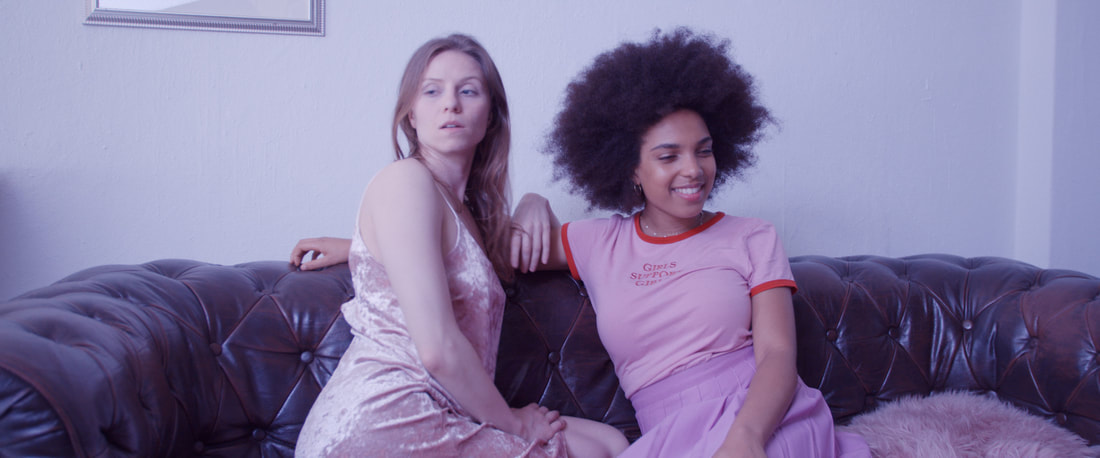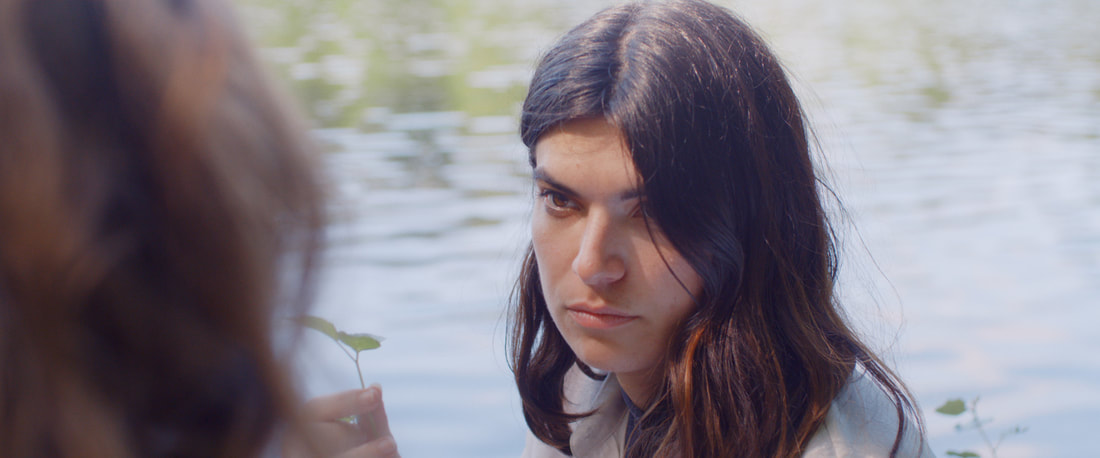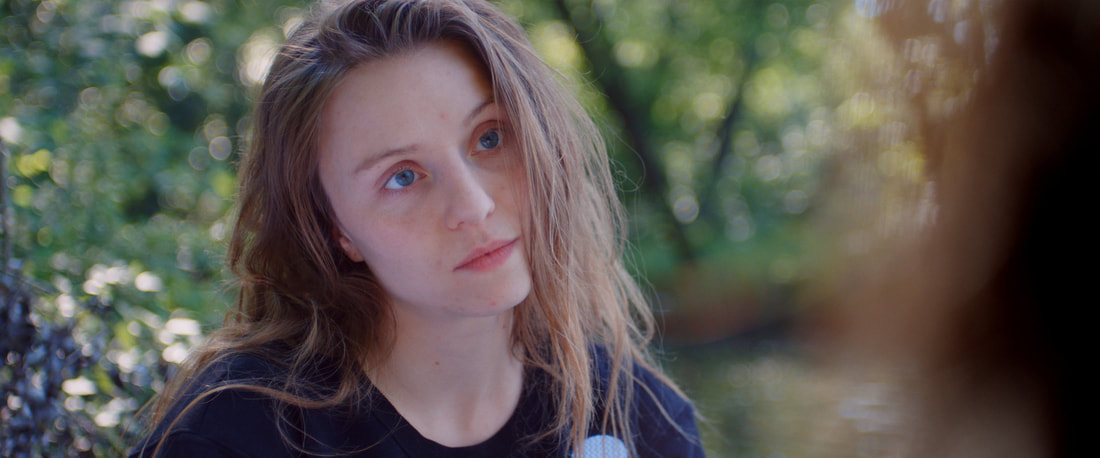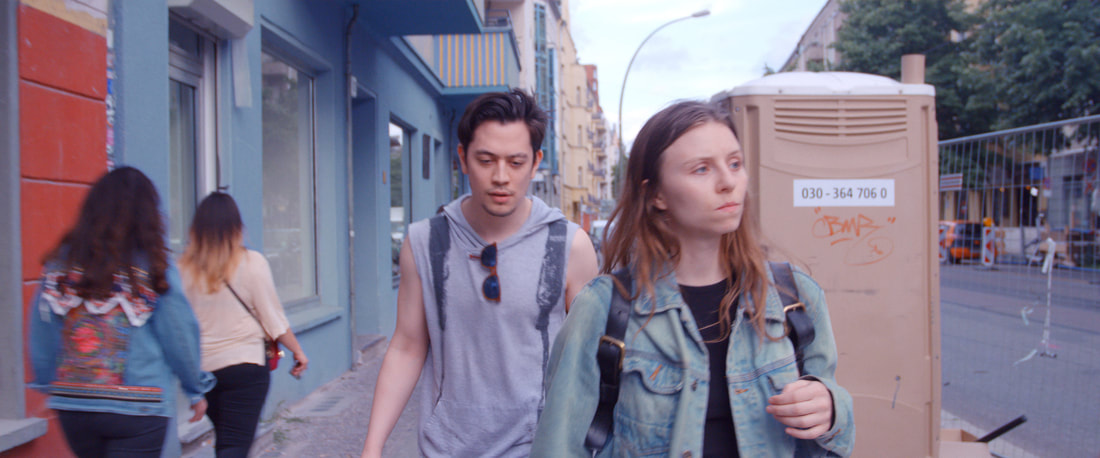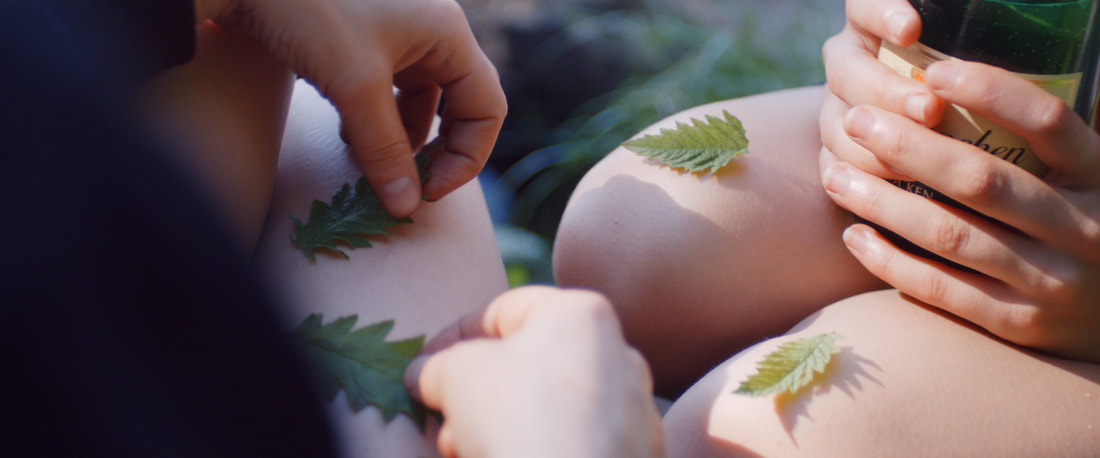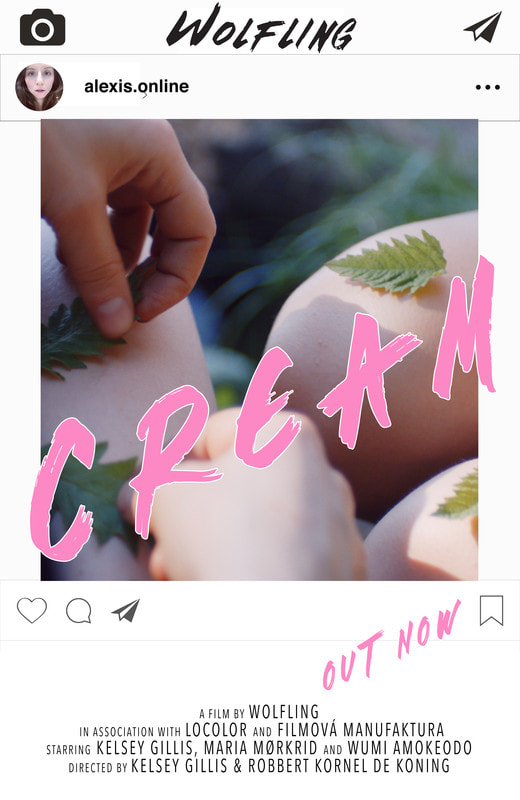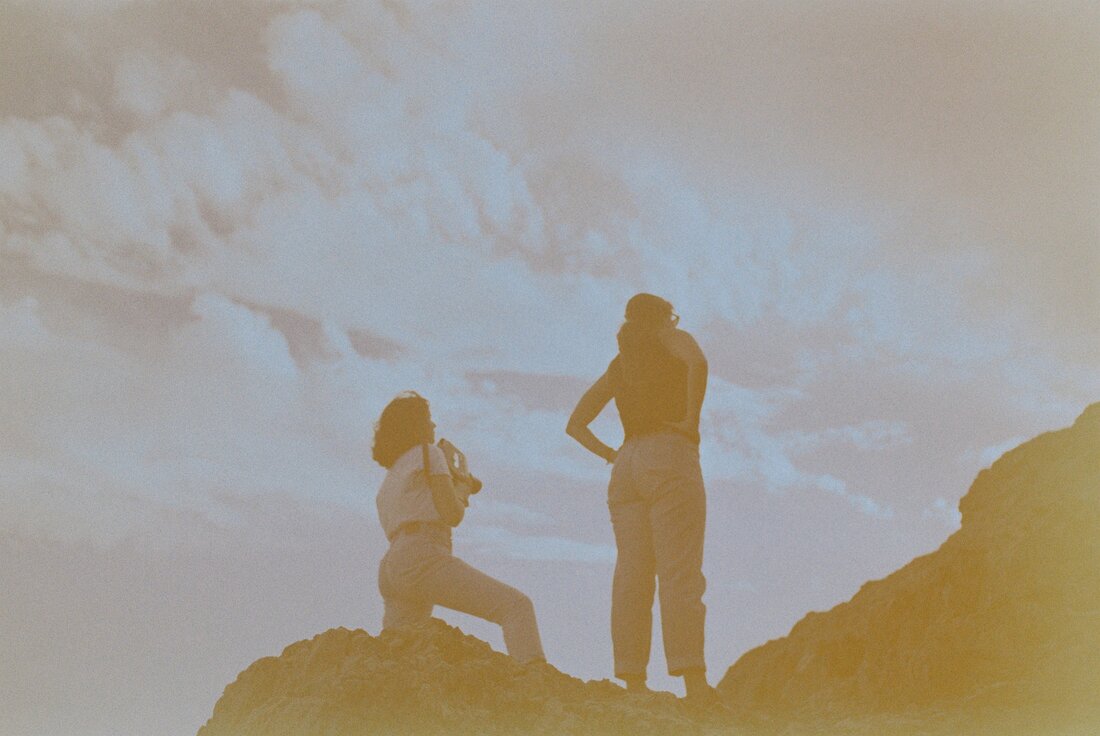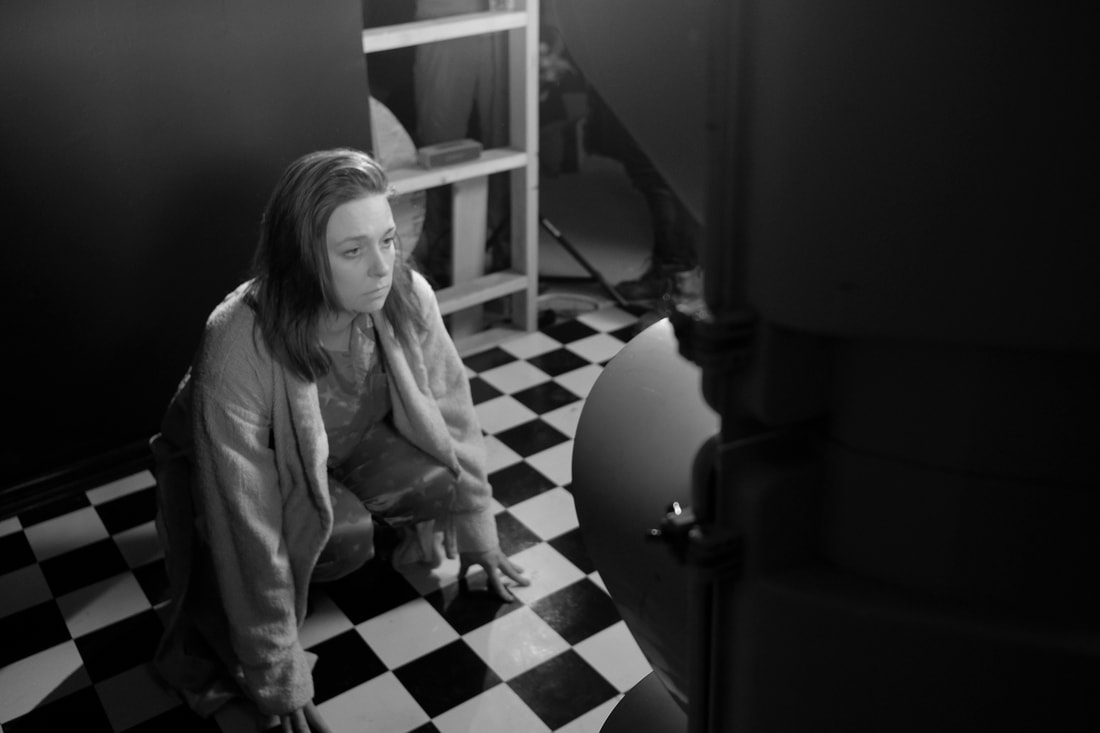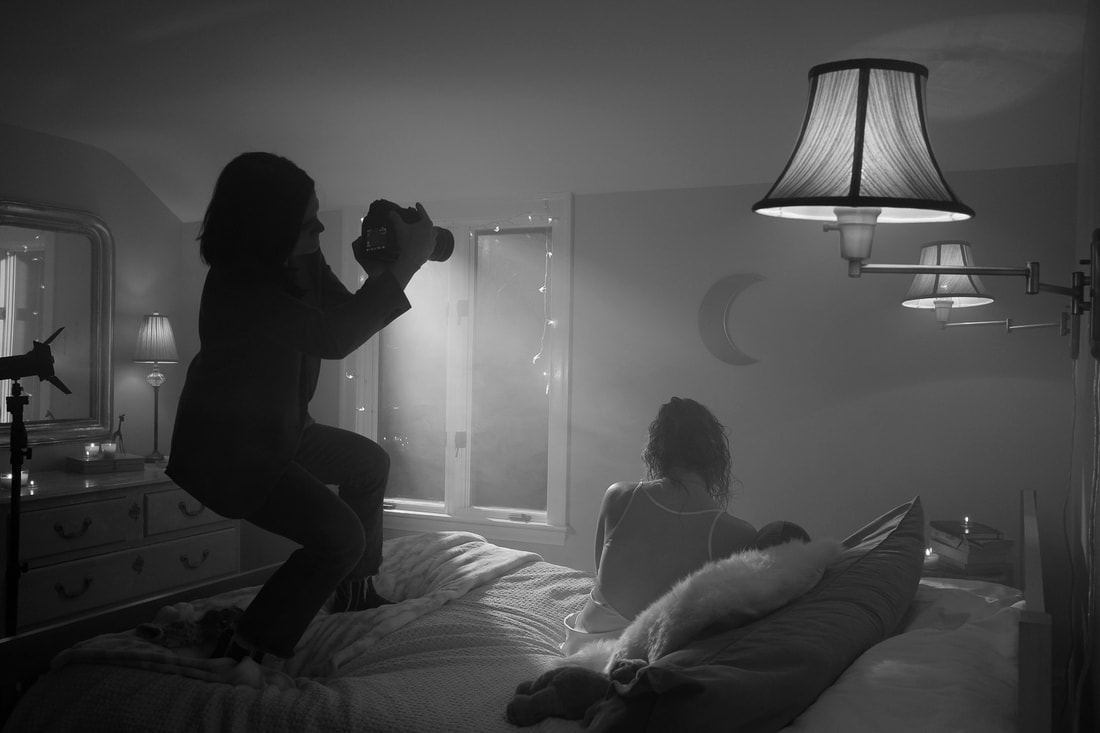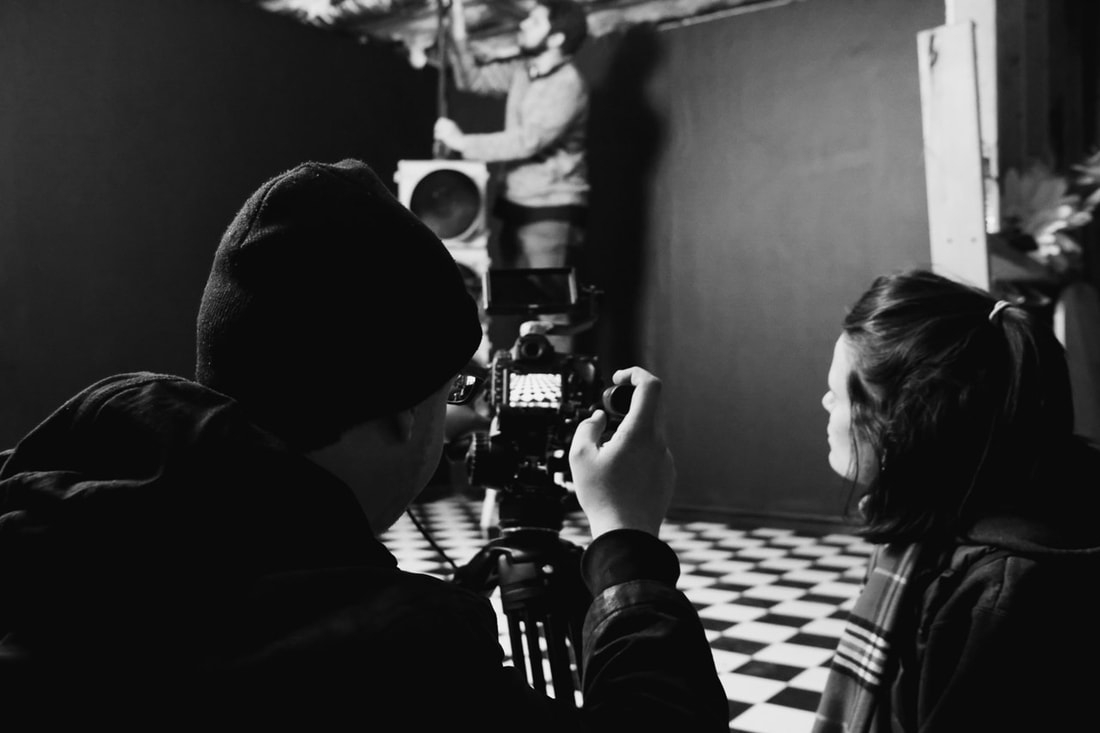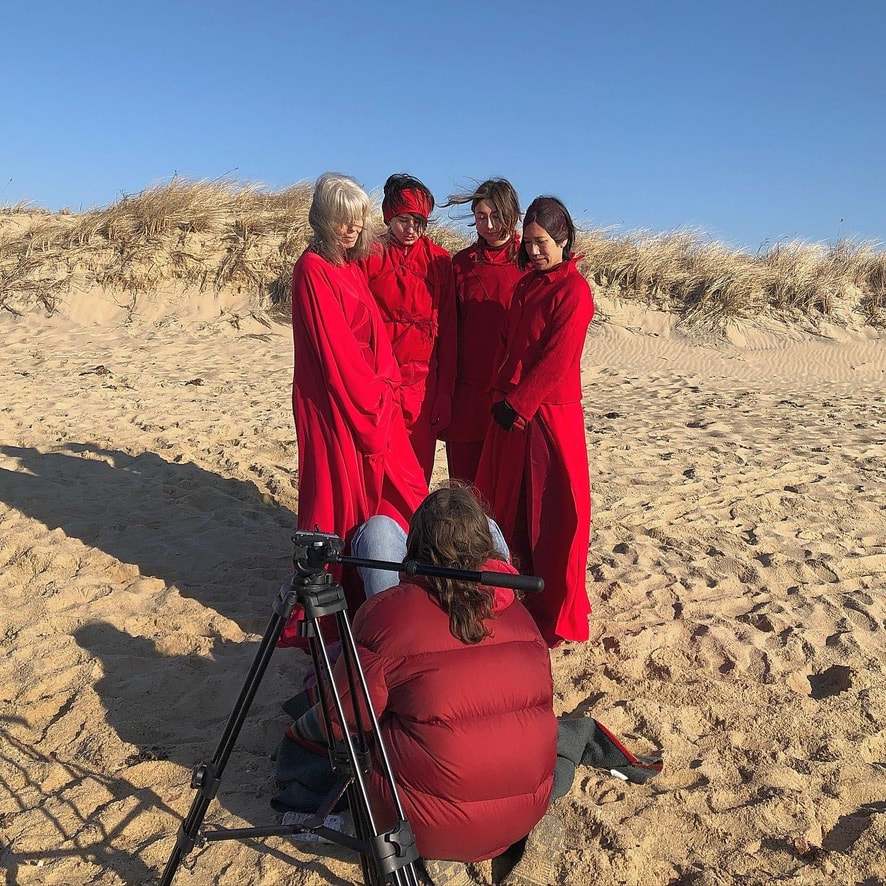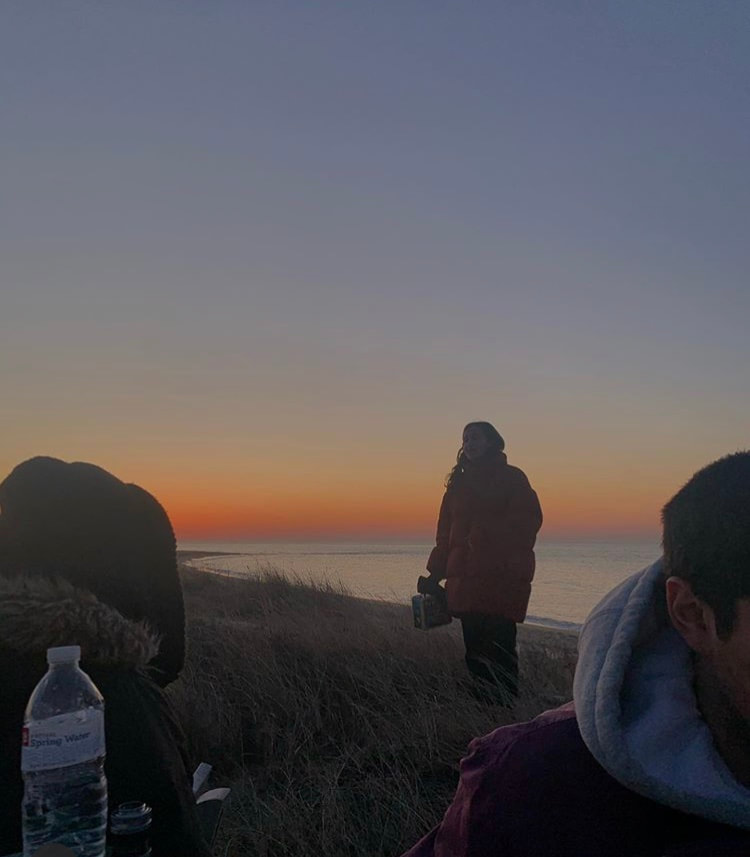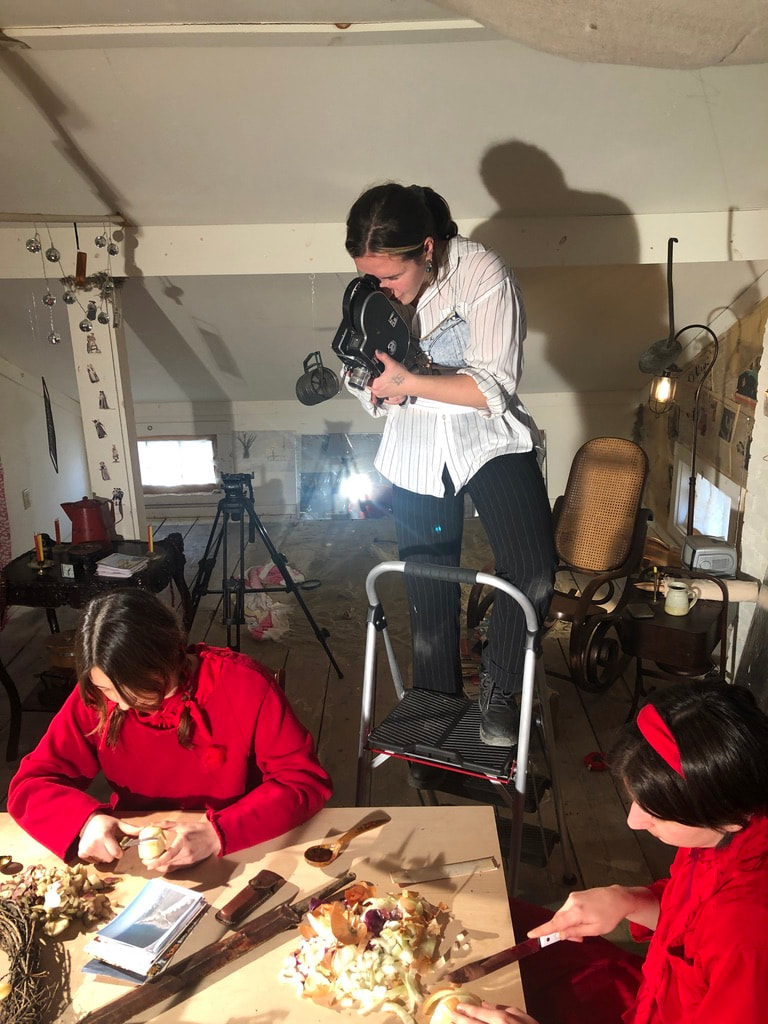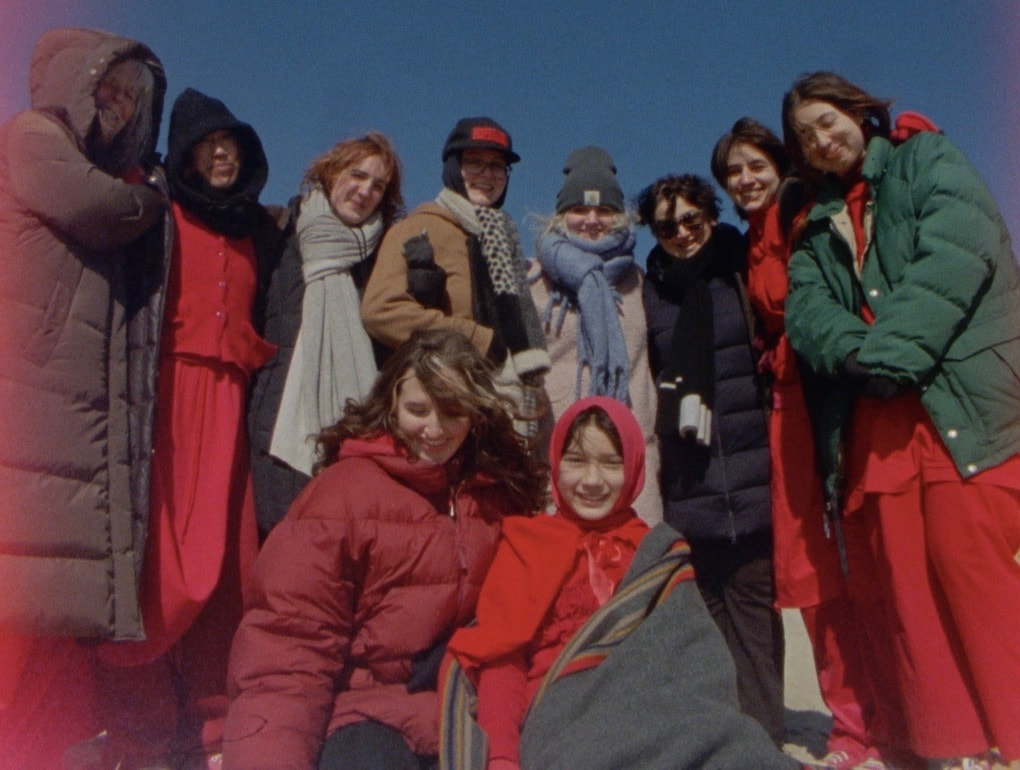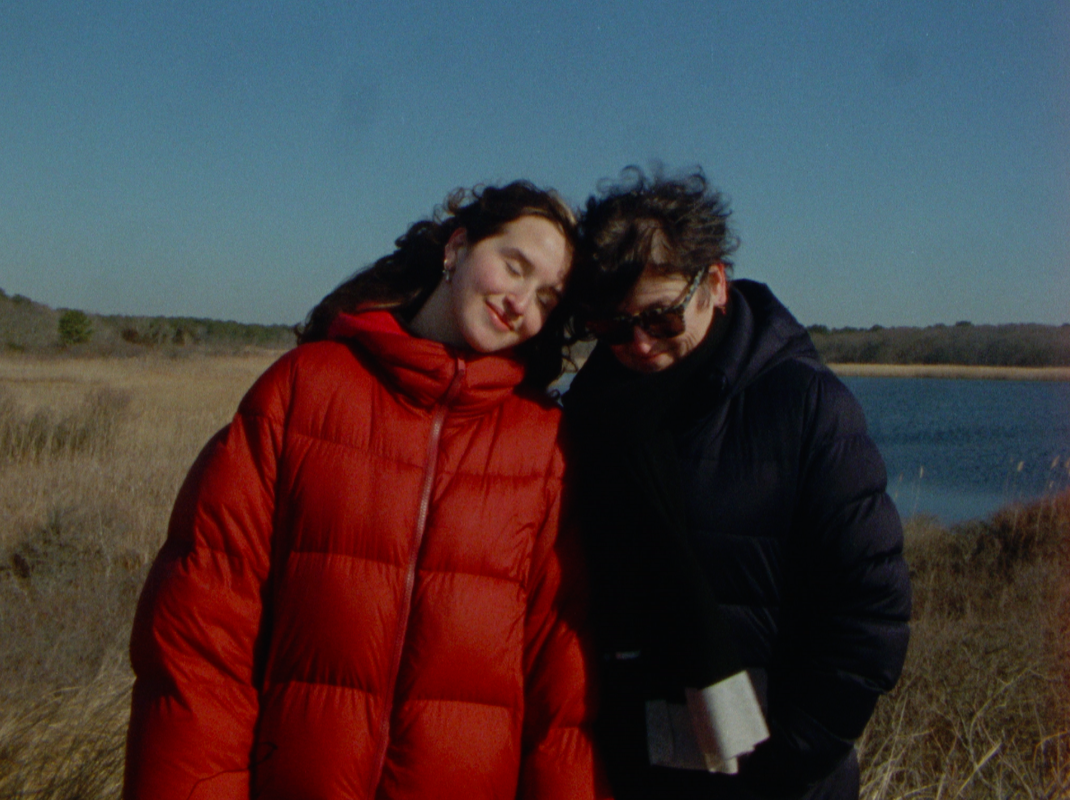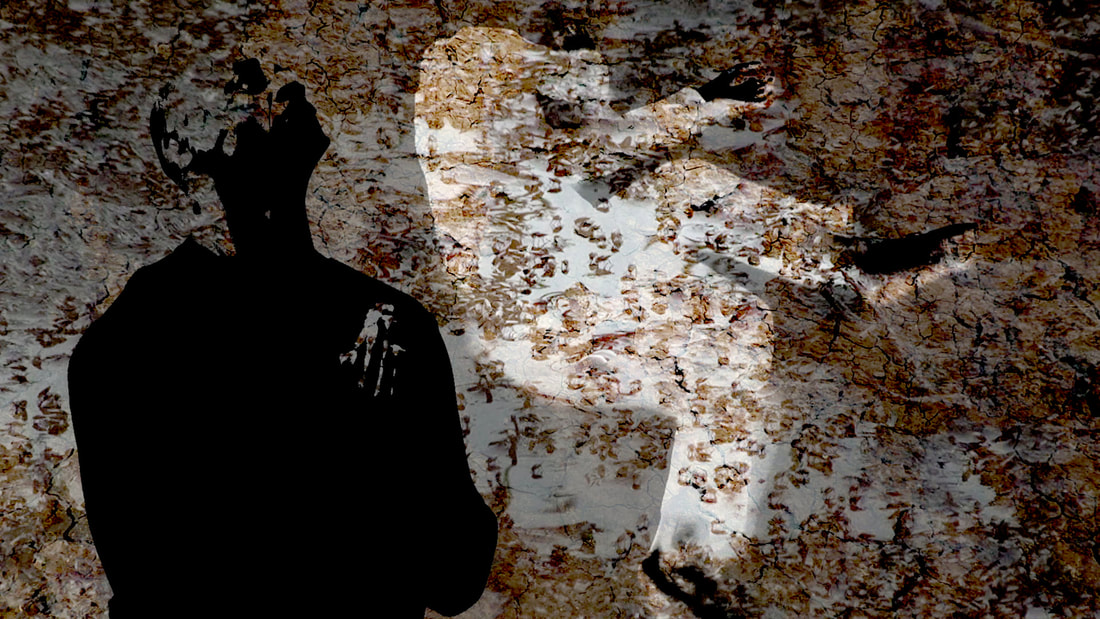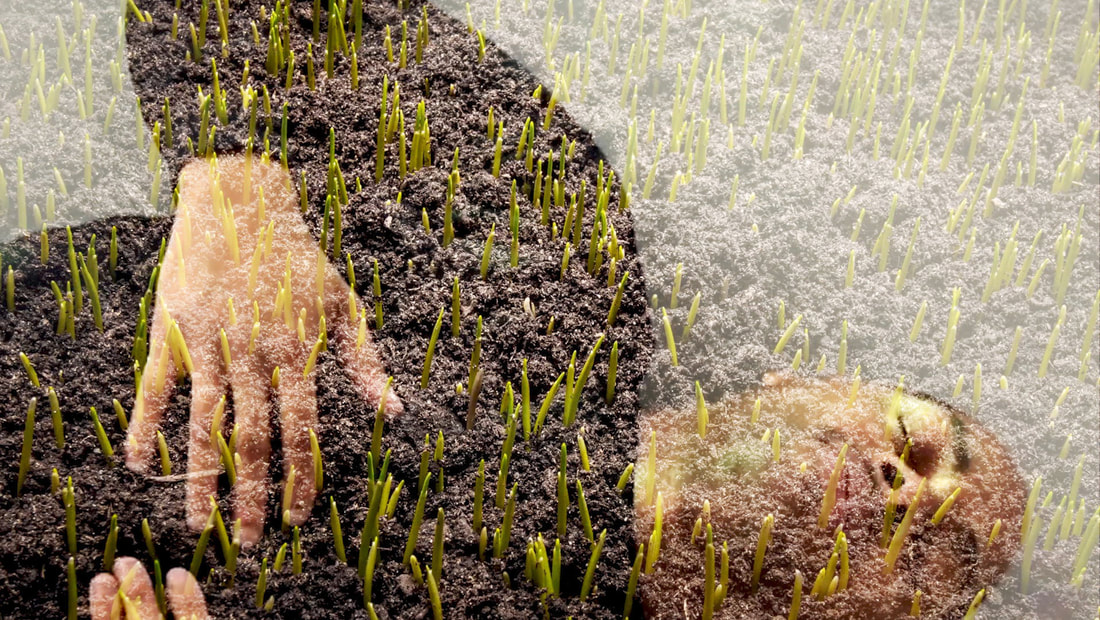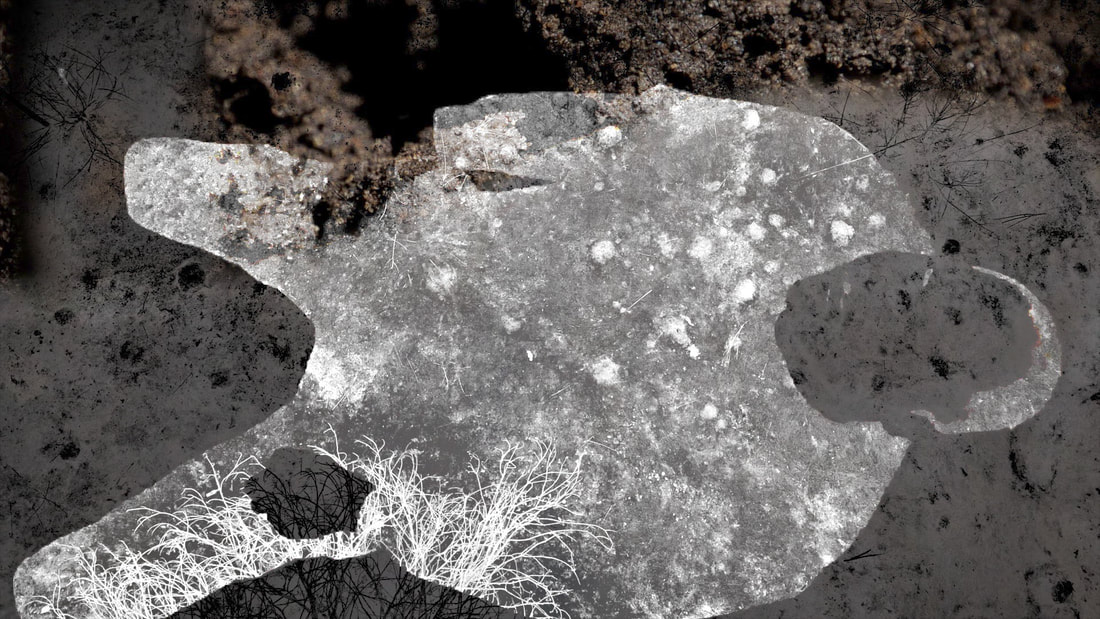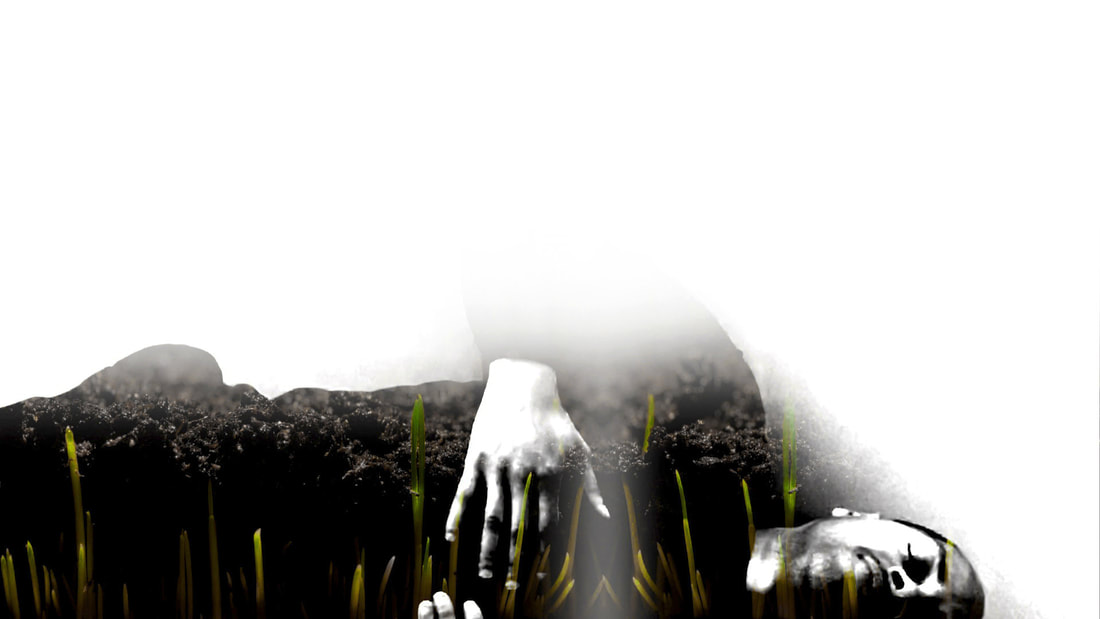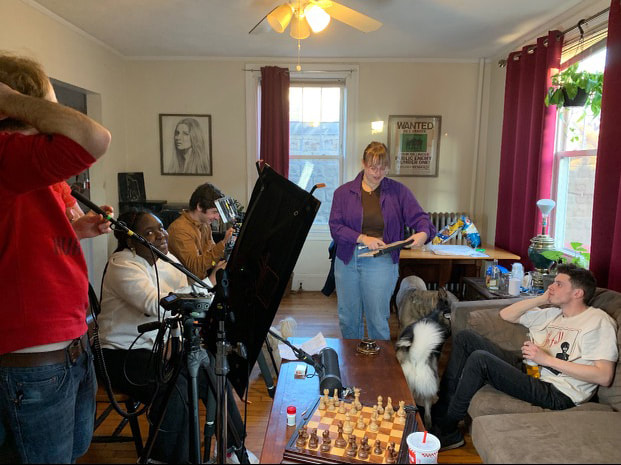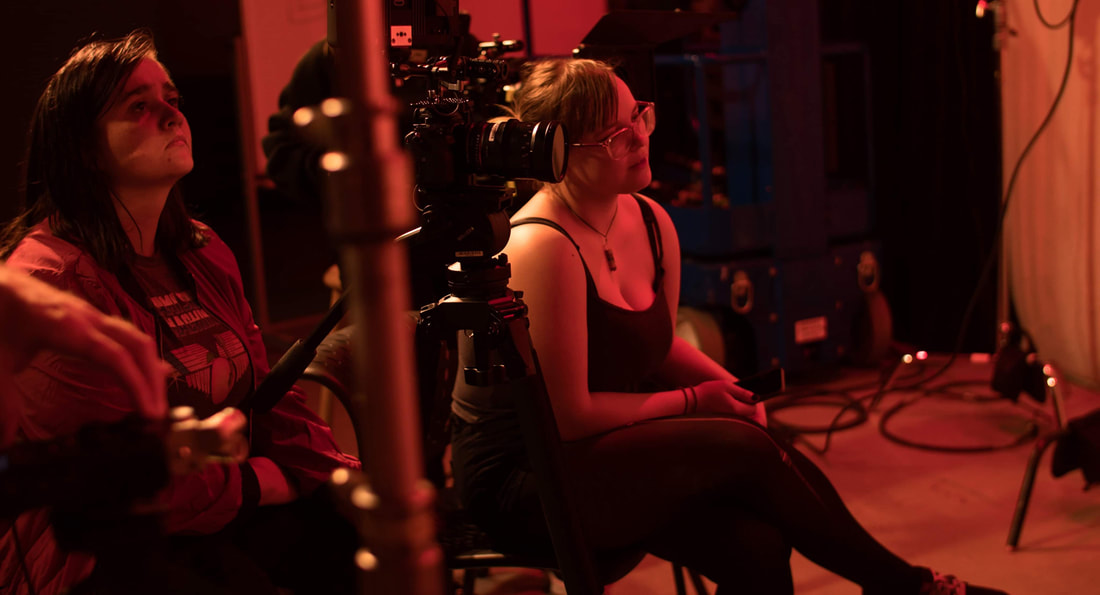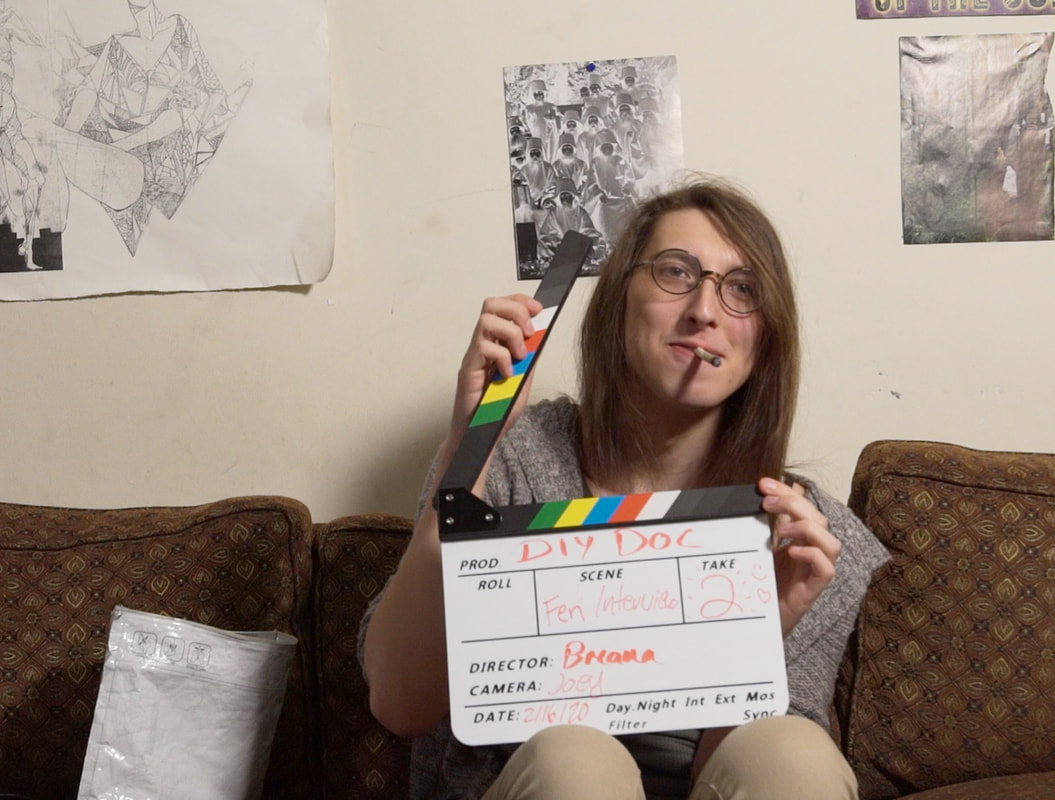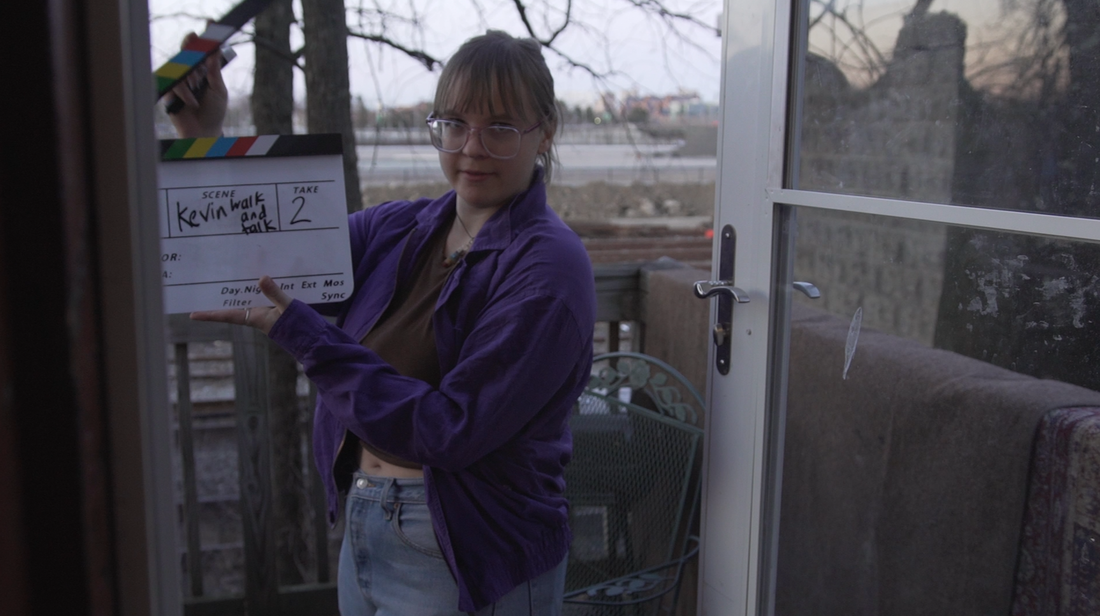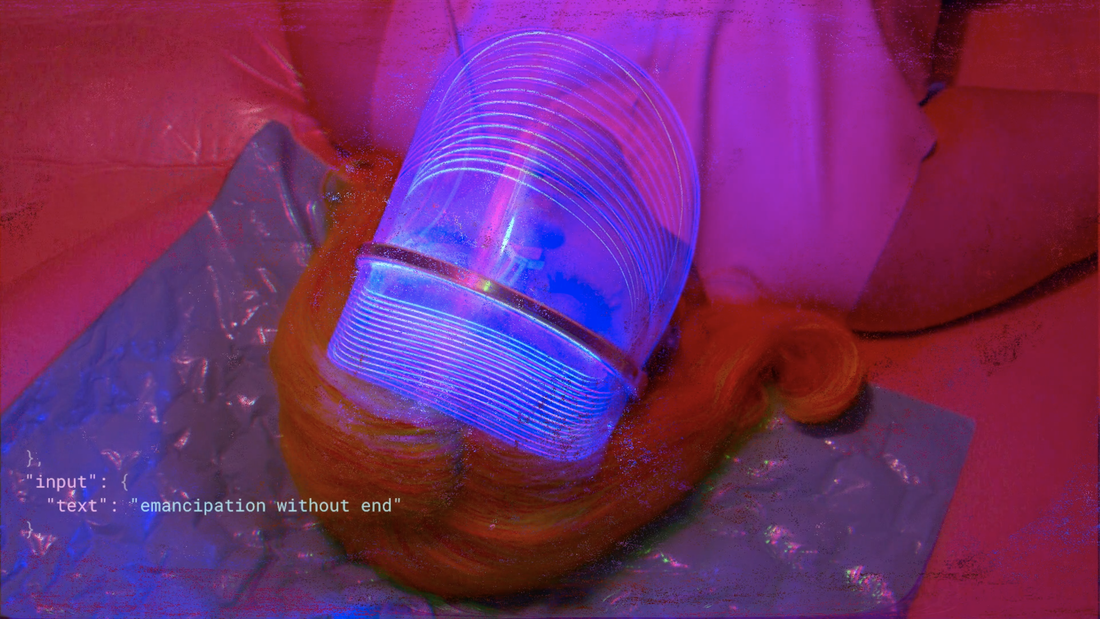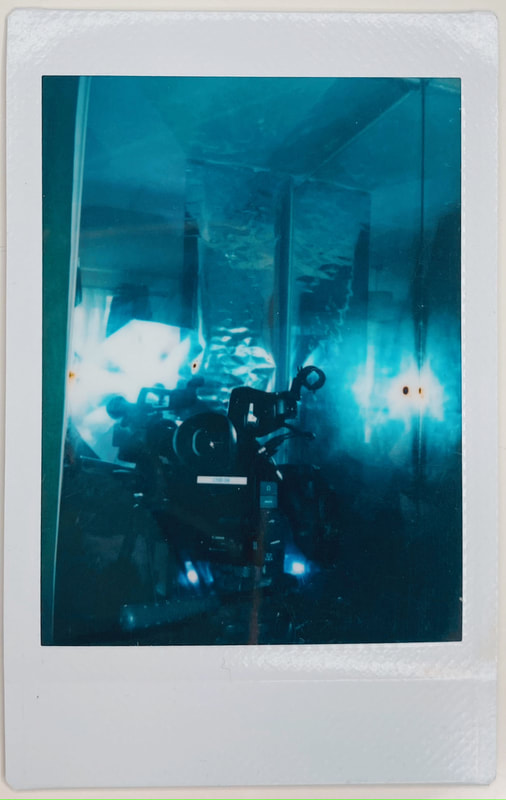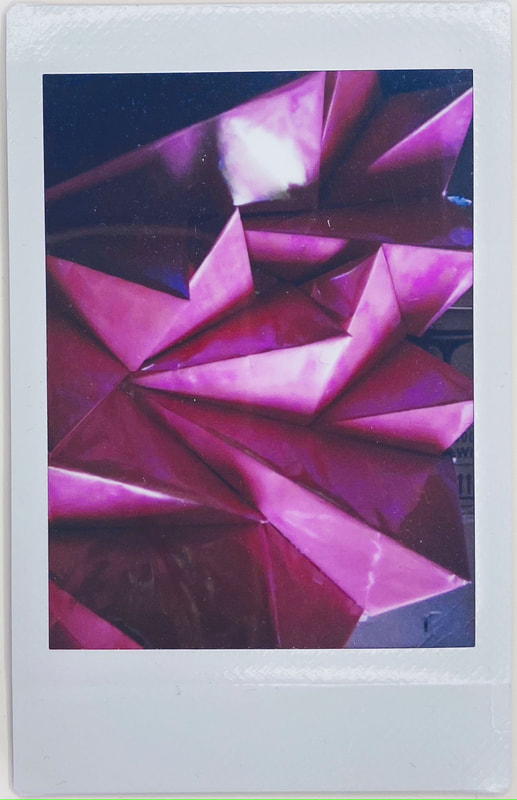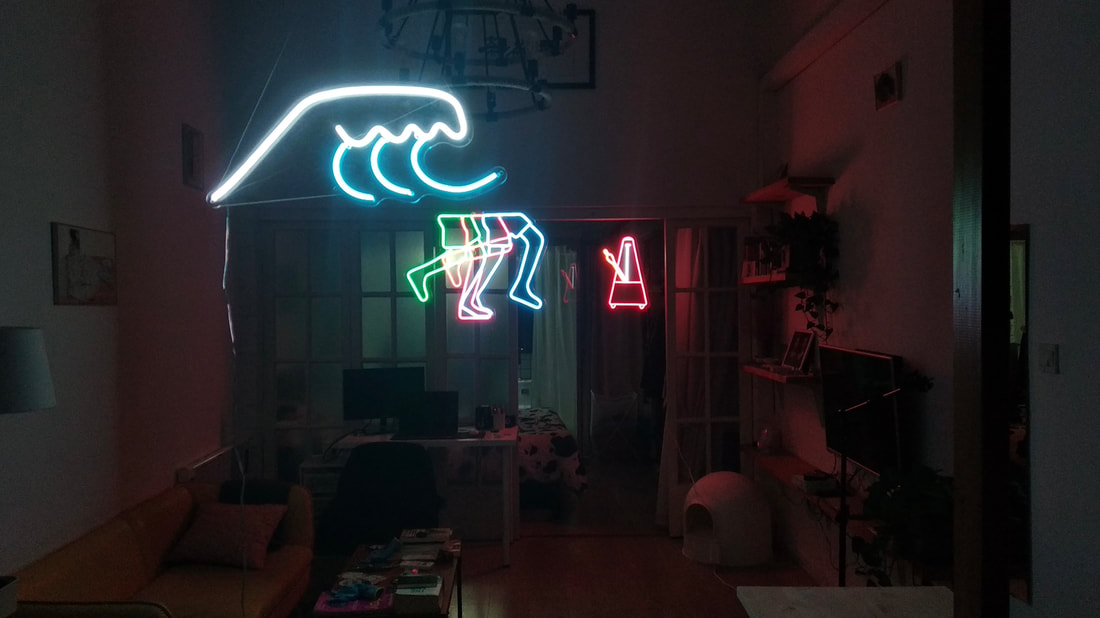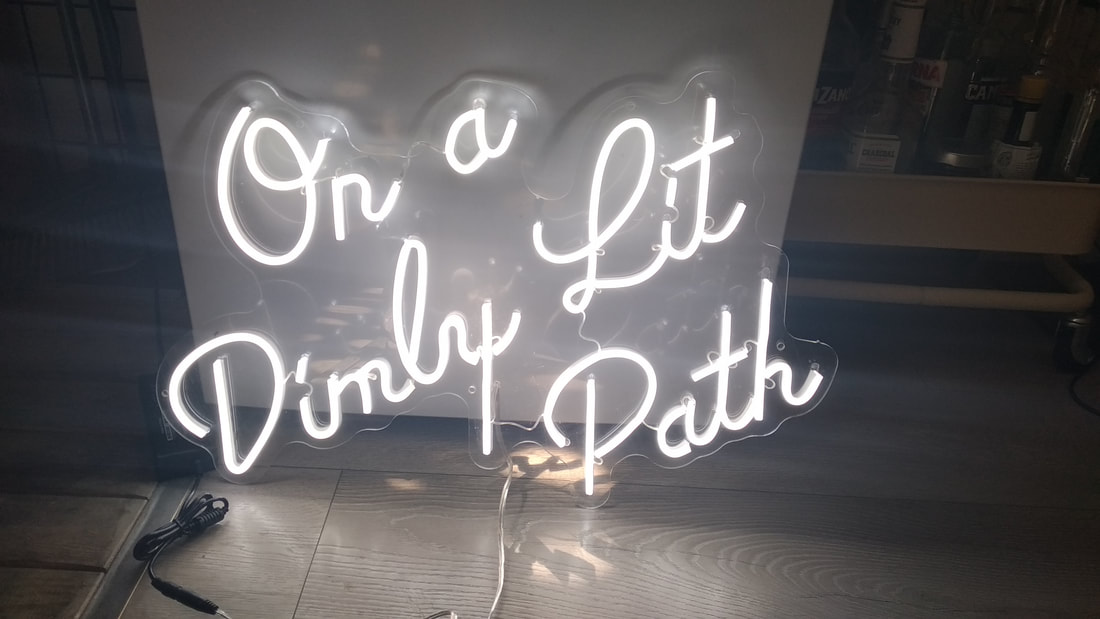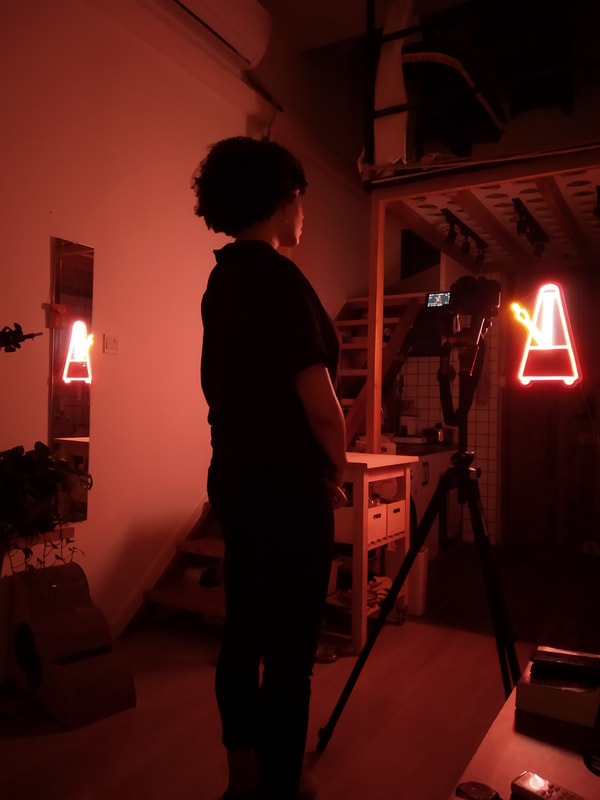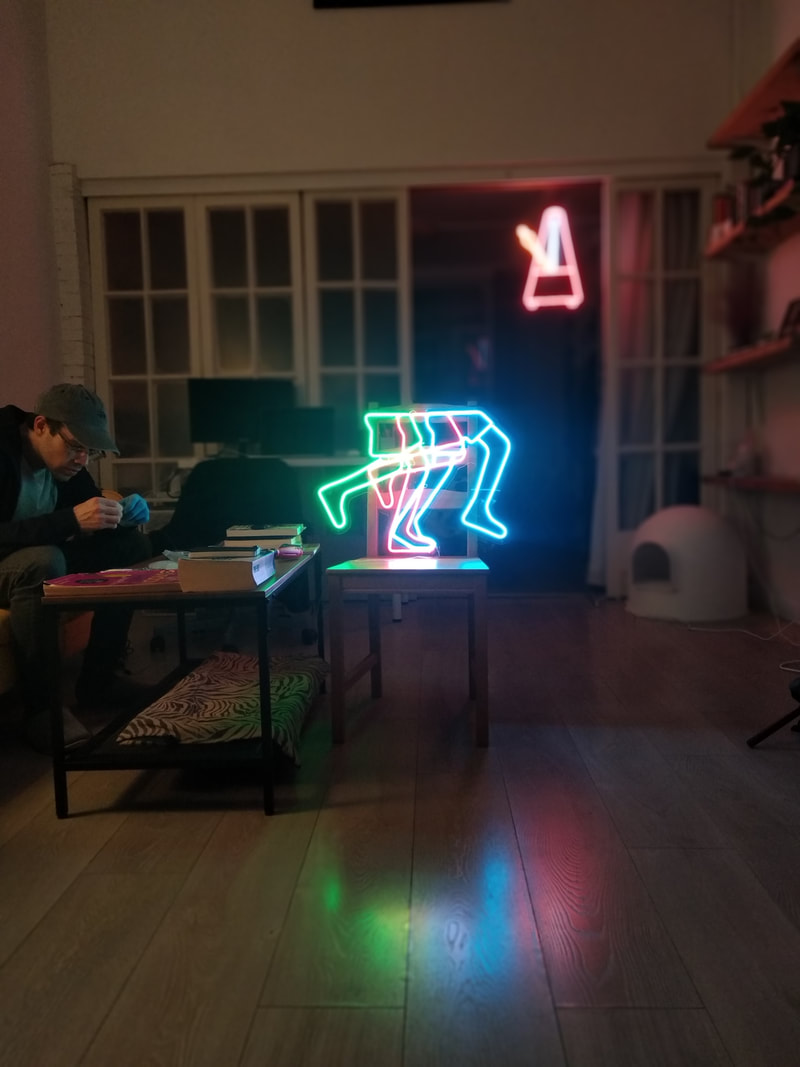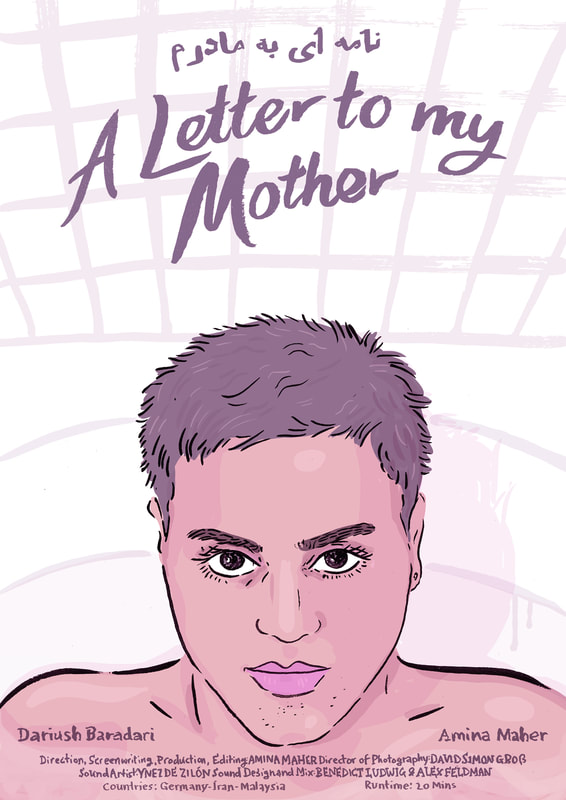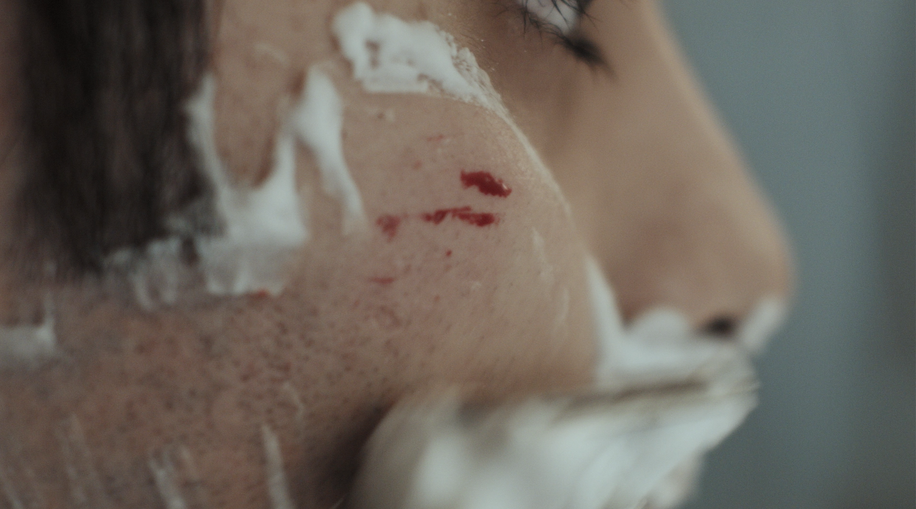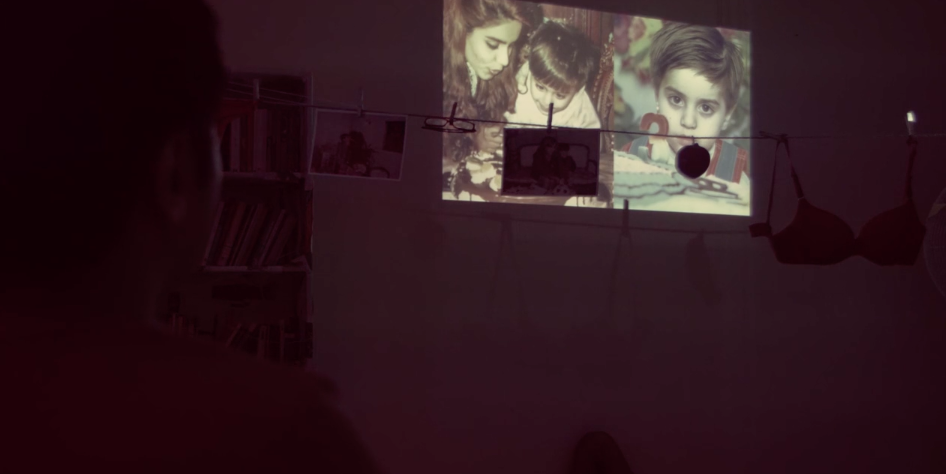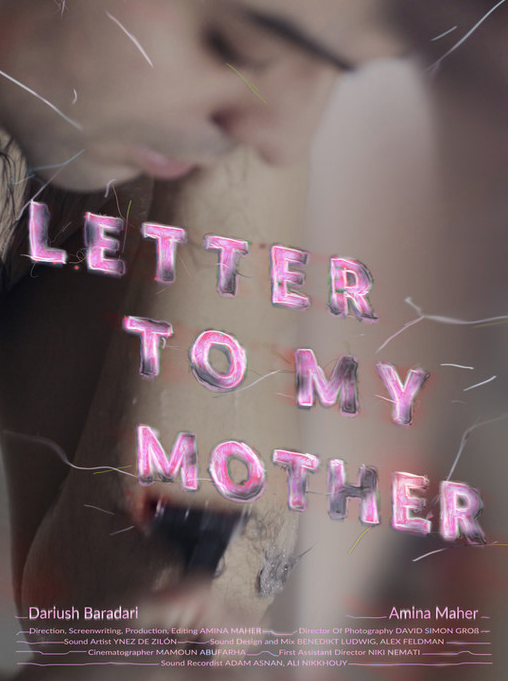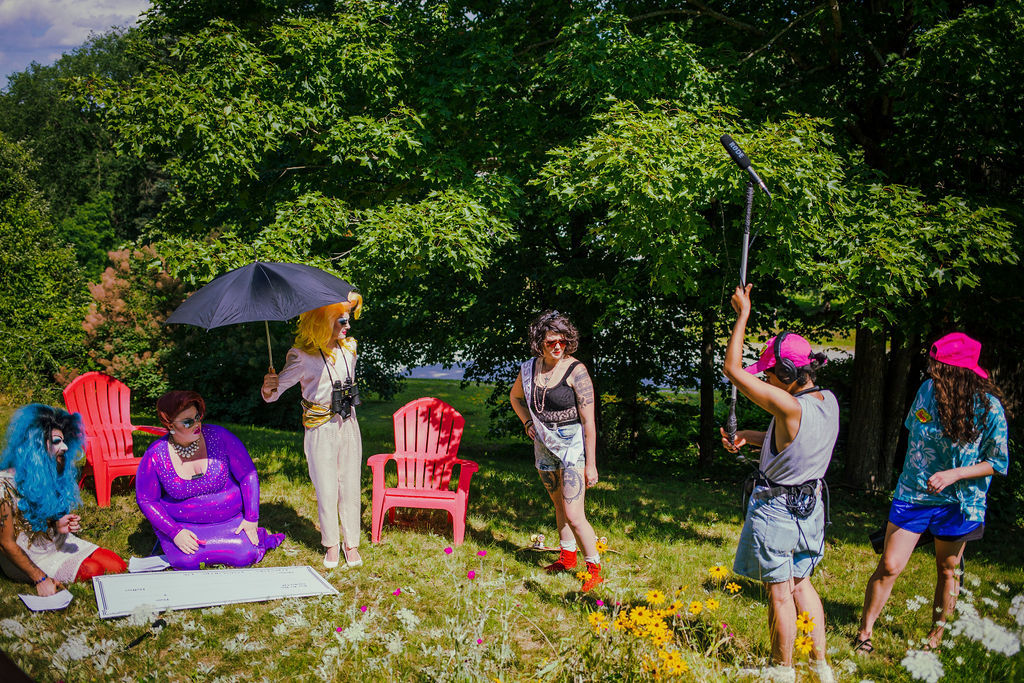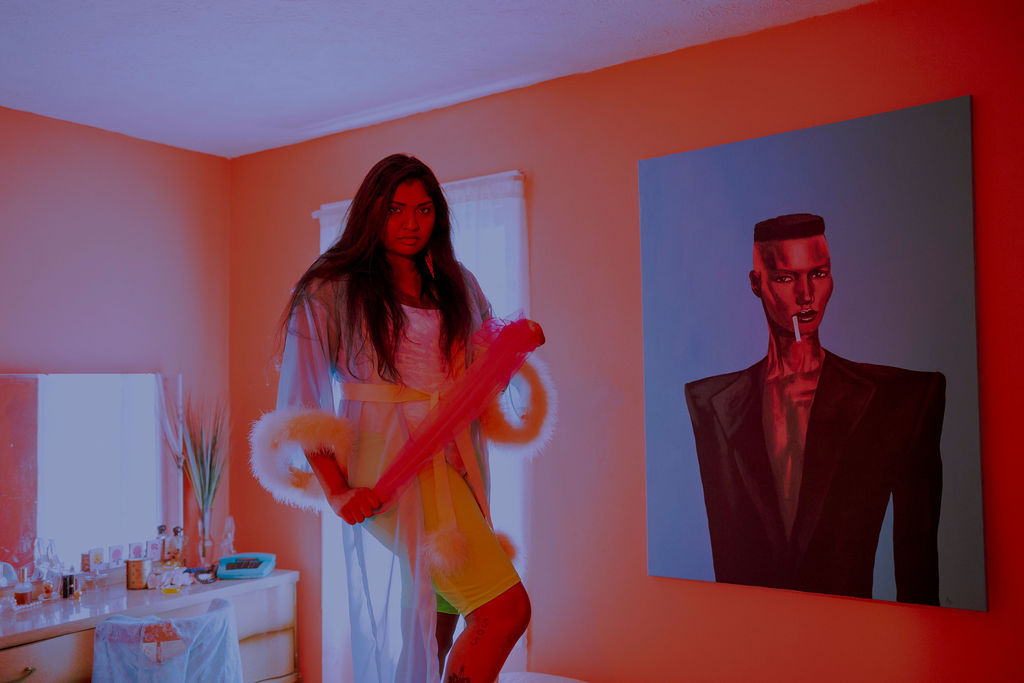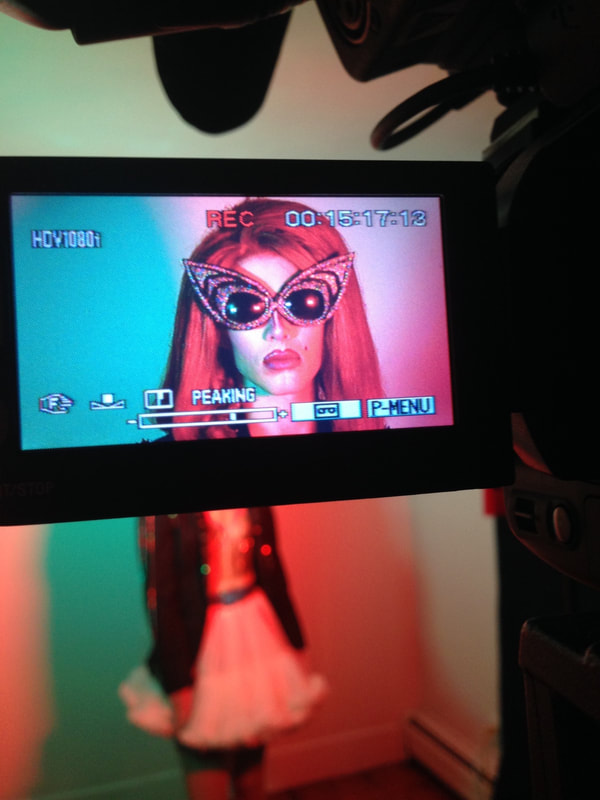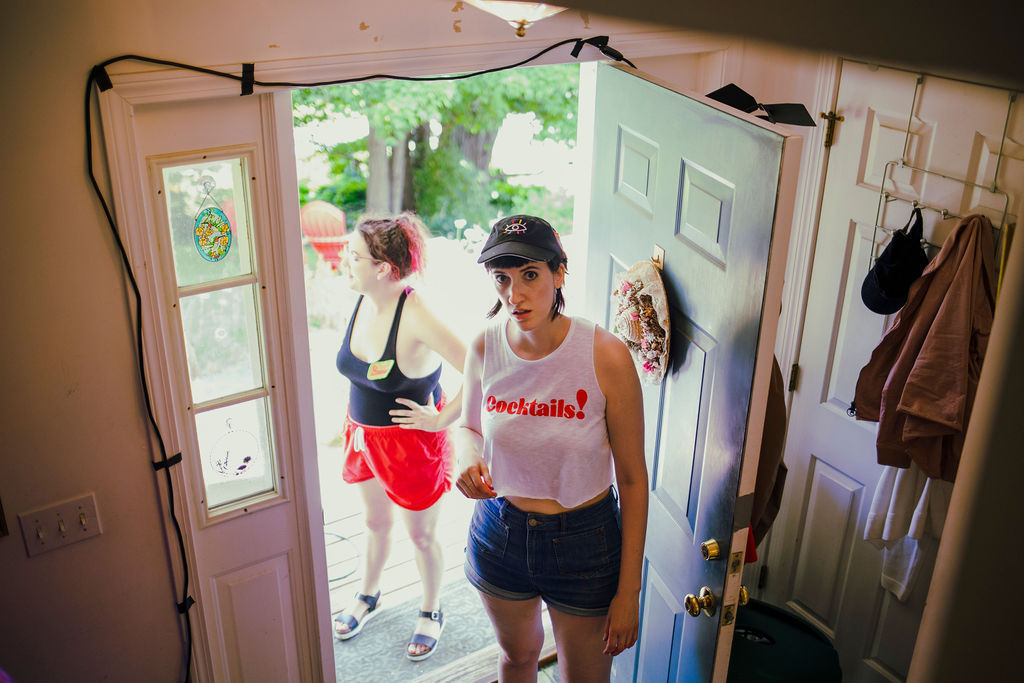|
Cream
While shooting on location in Berlin, a young woman reconnects with her estranged sister, unearthing the trauma that led to their rift. Cream is a character piece that looks at trauma, coping mechanisms, differing views, the familial sphere and how we internalize trauma while projecting it onto others. It views two siblings who exist within somewhat isolated spheres, whom until now, have failed to communicate due to the deep trauma and loss that has left them divided. Kelsey Joan Gillis was born and raised near the forest in North Vancouver, British Columbia to Irish-Canadian parents and has dual citizenship.Though always deeply connected to performing, she spent her adolescence in the Vancouver countryside, working with animals, horses and competing as an up and coming high level equestrian. After several years of travelling throughout North America and training with show barns, she shifted due to reasons of further self exploration and started to expand as a writer, actor and dancer, while simultaneously travelling and living around the world. In 2019, Kelsey founded the production company Wolfling with partner Robbert de Koning. Inspired by themes of awakening, the cosmos, trauma, transmutation, erotica and the human experience, Kelsey ultimately seeks to build an artistic bridge between the world of the spiritual and human. https://www.instagram.com/kelseyjoangillis/ https://www.instagram.com/wolfling.film/
1. How did this story come to life? This story struck me as a classic family drama, where tragedy brings people together for regrowth. Also very much about people’s attitudes towards sex work, and to women taking control of what men had monetized throughout the years (women’s bodies). How did all of these elements come together?
The film itself developed from an opportunity to do a camera test, and the story itself was an idea that had been percolating for a while. I had been previously inspired by a friend who had worked in the adult film sector of the industry and had done so for a while. Though, they were mostly satisfied with their occupation, they felt unable to share what they were doing for a living with their family, which put tremendous pressure on them. I believe they did open up to their immediate circle, several years down the line, and that transition wasn't unsimilar to what we explored in Cream. I wanted to start the continuous conversation on sex work in this film in particular, and will be exploring it in other projects to come to varying degrees. There is both a dark and light side to the sex work sphere, light being the work as an anecdote to the patriarchy and the the dark side being the slavery and trafficking of human beings. Though both are often thought as related, I do perceive them as coexisting independent satellites, that have depending on situation, sectors, place and persons involved, common exchange. I firmly believe that sex work is work, while trafficking is trafficking. In Cream, the focus was on our protagonist Alexis and the fact she felt very liberated in control, and empowered by her choices, even in the retrospect of trauma. Whereas when viewed through her sister Emma’s gaze, there was an underlying tone of bias, fear, prejudice and misunderstanding. My goal was to weave the conversation, within the context of a sibling reconciliation story, which looks at two very different, yet similar, sisters who have both been struggling with the semi recent loss of their mother. Ultimately, the focus is on what unites them, the subtext being their shared and respective trauma, within the sphere of how Alexis’s work shapes conversation within their lives. A lot of wonderful souls came together to make this little project happen, without them, it wouldn't have come to life at all. So I must give a heartfelt mention to two major contributors, our friends at Filmová Manufaktura and Cineready Rental!
2. A lot of the dialogue feels very natural and unscripted. How much was this improvisation or was it completely scripted? Can you describe the rehearsal and production process?
There was a script, with both dialogue and situations written in. However, as I wanted to work in improv as much as possible, the script was just used as a marker point. It was predominantly improvised and I cast individuals who I felt would play their characters close to the bone, so as to deliver as natural and honest performances as possible. The rehearsal and production process was both sweepingly chill and a bit rushed. Cream was born from a camera test that started as a scene and then expanded itself into a short. We basically had a week long window to prepare everything, and ideally, I would have loved to have been able to have done a proper full pre production on it. However, I am still pleased it turned out the way it did. Rehearsal wise, I workshopped with each actor and discussed the scenes, context and situations. As well as I went into character and stayed in character throughout the duration of the film's inception and wrap.
3. You’re the main actor in the film, as well as the director. How was the experience of juggling these two important roles?
It was definitely a new experience, and I luckily had my amazing co- director, and ride or die partner, who was the D.O.P. - directing alongside me. They were able to focus on the more technical crew aspects, while I focussed on the cast and the mis en scene. Then we would re-group and meet somewhere in the middle before each scene.
4. One scene that effected me was the street harassment scene. Why did you include that in the story?
I actually took that scene right out of my own day to day experiences as a female and that of those who are female identifying around me. I have experienced situations like that myself, whether in physical actuality or in paranoia, in which anxiety builds, situations run though your mind and you start thinking in all kinds of scenarios. The scene also serves as an homage to the friend whom inspired the film and pays tribute to a story they told me once. Which in brief; involved them attending a regular, vanilla acting audition with a known director, who completely creeped on them during a pre #metoo era audition. In which he dismissed their work in the room, and lewdly complimented on how familiar was with their other work, and that he considered himself a fan of their more explicit content. My friend had felt totally exposed and devalued after that as an artist, and that story has always stuck with me.
5. What are you working on now? Any upcoming projects?
I am working on a few feature scripts that I am really excited about. Unfortunately, they do have slight NDA’s attached, so I can’t really share much information about them as of yet. But I am going to delve deeper into the realms of sex work, the undergound, mythological creatures, horror, nature, galactic themes and hope to create some really cool genre pieces in the near future now ;) NOWHERE BUT HERE from Carolina Romillo on Vimeo.
NOWHERE BUT HERE is an exploration of the concept of identity and binationality through movement. The struggle to fit in, be accepted and understood.
A dialogue between cultures and identities that goes from opposition, adaptation and, finally, surrender to being oneself. Carolina Romillo Marín is a writer and film director. Originally from Havana, Cuba, she moved to Barcelona at the age of five where she later decided to study Film and TV at Blanquerna Comunicació (Universitat Ramon Llull). After a short time in the production field, she quickly became interested in directing creative documentaries. Later on, she decided to write and direct her first short film on dramedy genre, „A different afternnon“, with which she won the award for Best Forreign New Director at Winchester Film Festival. She's currently living between Berlin, Havana and Barcelona, exploring analog film and focusing on experimental and contemporary dance films. Among her recent credits are “Inside/Outside“ (2020), Best film at MITS Barcelona 2020 and selected at many international film festivals; “Nowhere but here“ (2021); “Loving too much, too less“ (2021); and “The Power Upon Us“ (2021). Due to her multitasking nature, it is quite common to find her editing, shooting and producing her own films. She stands for strong narratives, emotional content and captivating visuals. https://www.instagram.com/carolinaromillo/ https://vimeo.com/carolinaromillo https://cargocollective.com/carolinaromillo/
Interview questions from Lindsay Zasada
In your short film, several questions are presented. (Where do you come from?, What do you leave behind? Where do you belong? What are you made of? How do you adapt? Where do you feel at home?) Are you asking these questions of the viewer, or of yourself? How would you answer them for yourself? These questions are presented as an interaction between the performers as well as with the viewer and myself. Questions that I have always asked myself and have been uncomfortable trying to find an answer to them since I have always had a lot of confusion when it comes to my identity. I was born in Cuba but moved to Barcelona at the age of five. I struggled a lot for being accepted in Spain as I was used to another behavior and environment. I have even being bullied for acting different. Every summer I went back to Cuba to visit and spend time with my paternal family. Alongside and over the years, I began to hear not only judicious and separatist comments from Spain but also from Cuba. My accent began to adapt as well as my behavior so I started to be something of a weirdo for both cultures. Over the years I have come to the conclusion that I am a citizen of the world in constant movement and my identity is formed by the experiences lived in all the places that I have been able to visit. By the different cultures, ways of feeling and understanding the world of people who inspire me. I am fascinated for multiculturalism and that is why I decided to live in a place like Berlin, where so many cultures coexist and we can find a high level of freedom and respect. When I ask these questions through my short film, I am looking for the discomfort that I feel when receiving them or trying to answer them. Questions that, although define us, it also limit us and are often unnecessary for the increasingly globalized world in which we live.
The setting is beautiful and gives the film a very ethereal vibe. Where was the location of the film, and does it hold significance for you?
The location is called "Cova del Llop Marí" and it is in Tarragona, Spain. „NOWHERE BUT HERE" is an exploration of the concept of identity and binationality. This is why it features a cuban (Jennifer Tejeda) and a spanish (Alícia Pírez) dancer and I wanted the location to be in one of the two countries; specially in the one where I felt more confussion and discomfort regarding my identity, and that`s why I finally decided to shoot it in Catalunya. Then I started looking for locations near the sea since this is the element that separates the two countries and at first I thought of making two pieces (one in each location) and merge them by the sea. Later I disgarded the idea of the two merged pieces and decided to look for caves until I found the "Cova del Llop Marí". A cave to represent the identity, the deepest and most sincere part of us, what makes us unique regardless of nationality. And last but not least, the sea has always been an special place for me. A place where I feel totally safe and at home. The sea and the moon. The film’s theme seems to include the notion of the ocean inside of us (the waves introducing the film, a rush of a heartbeat, a pregnant mother, the waves carrying the dancers away). How is this theme interpreted through the character’s dance? As I said before, the ocean is a key element in the film and I wanted it to, little by little and as the film progresses, to gain strength. The creation of the movement was a process that I carried out together with the two performers, working from keywords and images I gave them as well as separating the piece into three parts: opposition, adaptation and, finally, surrender to being oneself. Water is the component that frees us from prejudices and mental limitations. Depth of feelings and adaptation... It adapts to different forms and it allows you to built your own and unique shape.
I find it interesting that the contemporary dance is performed not by two people, but actually by three. How has the decision to include a dancer who is with child impacted the performance and the overall meaning or significance of this piece?
When I started to develop the concept of the piece, I didn't think about featuring a pregnant woman. The initial idea was to show a Cuban and a Spanish dancer. I quickly found out that Jenifer Tejeda was currently living in Barcelona and I did not hesitate to call her as she strikes me as an extremely talented dancer who I had previously worked with in my documentary „Danza Contemporánea de Cuba on tour" (2019). The big surprise was to find out that she was pregnant. I immediately realized that her condition would not be an impediment but contribute to the piece and the theme we were going to work with. When you are pregnant, you are somehow creating an identity and she was going to do it in a new environment for her regarding her Cuban roots. On the other hand, I believe that dance is possible and is beautiful in all its forms. At any age, in any condition and any way. What are you working on currently and what can we look forward to from you in the future? Right now I am fully working on the post production of my two most recent films. "Loving too much, too less" is a short film born from an original poem and the need to portray it through camera and body movement. The piece features a dancer who just got out of a failed relationship. During the duel, he remembers and idealizes his past, trying to understand and manage his emotions, seeking some kind of satisfaction that could fill a great internal void but nothing seems to satisfy. An ode to love, excesses and desperation to find something real; a right way to love. "The power upon us" is an experimental video art together with ten performes who represent the planets of the solar system and the moon as the main character. Individually, each performer personifies the energy and attributes of each planet and expresses it through movement and sound, using their body as an instrument. Together and through the interaction between the moon with each of them, they deal with the concept of power; the capacity that each of them has to influence the behavior of the other and that they have on us. On the other hand, I am developing a new piece called "Estampida" with the dancer and choreographer Julio César Iglesias Ungo. “Estampida” emerges from the idea of the future, in how to recover the capacity to envision other possible worlds.To deal with the feeling of exhaustion and discouragement that seems to overwhelm bodies today. We propose reviving the capacity to build a hopeful future. Against the multiple dystopian examples that surround us, this research focuses on developing our view of the future.We trust that the power of what is possible can only be boosted if we are able to imagine it, and this is an opportunity to do so.
You Don’t Have To Take Orders From The Moon
A short horror film about a tortured woman who must decide how deep into her own darkness she is willing to tread as a looming, omnipotent force promises her everything she has ever wanted. Jaina Cipriano is a Boston based artist working with photography, film and installation. Her work explores the emotional toll of religious and romantic entrapment through immersive sets and emotional performances that mirror the subconscious. jainaphoto.com instagram: @jainasphotography
Interview questions from Lindsay Zasada
What is the significance of color (and lack thereof) in ‘You Don’t Have To Take Orders From The Moon?’ This is a film about codependency, abuse and the absolute hold it can have over you. You don’t have the luxury of dreaming when your life is that scary. Your existence is stripped down to absolute essentials. That’s the world Cynzia is living in when we meet her. She is in survival mode. The new girl at the end is in the honeymoon phase, being gifted and graced by these celestial, male forces. She feels chosen, special. Her world is bright, open and there is the possibility of something beautiful happening. This transition was not actually planned for, it happened naturally in editing.
One of my favorite scenes in this film is right after Cynzia is confronted by Carol outside of her house. Can you elaborate on the significance of Carol’s association with the sun?
Carol was Cynzia’s chance to turn the night around. The actresses and I talked a lot about how everything in this film was taking place on The Last Night - meaning there is a lot of built up momentum spurring Cynzia towards her demise. Carol was a reminder of reality, hope, of the possibility of turning things around. Carol was based on a friend I had in high school who found me crying in the hallway. She stopped to see if I was okay and I wanted to explain to her this existential fear that had gripped me in the middle of the day but we didn’t know each other well enough. She told me to call her if I needed anything and then went back to class. She meant well and her kindness was appreciated but I remember my bad feelings did not even budge. Carol was a little bit of sun shining into Cynzia’s dark night. But Cynzia is too far gone, too impossible to understand. She needs more than a little sun to turn the night around now. Can you tell us more about the unseen protagonist of this film and what ‘He’ represents? He is so many things. He is the man who promises you the world - doing everything in his power to make you fall in love with him but then turns his nose up at you once you’re committed to him. He is the hungry, codependent love that empties your heart. He is a trickster, a narcissist, he is the vengeful Old Testament God I spent my childhood terrified of and praying to nightly.
Your photography work is beautiful and surreal. What influences the narrative worlds of your photographs, and how has this helped you create the narrative world of this film?
My photographic work explores the emotional toll of religious and romantic entrapment through immersive sets and emotional performances that mirror the subconscious. I work to challenge the fear-based narratives that have been fed to me my whole life. Being raised in an evangelical cult I was unable to explore both the physical world and my internal world freely. Everything I create is to shed light on my fears. There is incredible power in making a drama out of something painful. It frees me from my past and connects me to my future. It opens me to new connections. What do you currently have in development and what can we look forward to from you, in the future? Currently, I am in pre-production for Trauma Bond - an intense coming of age film where a girls night between two best friends takes a dark turn after one of them invites a mysterious newcomer who promises emotional salvation. It is based on an experience I had in my early 20’s. I also am working towards a soft launch for Finding Bright Productions this summer - a Boston based production company specializing in custom set design for music videos. My team and I have spent the past month in the studio creating an enormous board game set for our first video!
Somewhere we cannot explain, in a future defined by past idioms, when the consequences of reality have had time to wash over, there lived five women; a family of some sort. Ascending from youngest to oldest, there was Silisa, the tiptoer; Kysham the thinker; Titsa the brave; Anyela the strong; finally Yaba the willful. No one knows how to reach this world; rather the women that live in it have learned how to sustain their livelihood. They rely on each other to survive.
For generations, these women have all consumed the sun, which is their driving force. Each day, they collect objects that fill-up their entire home, the most mysterious being the lost postcards. These cards appear in the sand each day with messages from Crimea, signaling to other worlds; other times. These messages are the portal between their world and ours; through past present and future; symbols of memories and trauma. Silisa, being the youngest, often ran far distances and played in her own secretive universes. When her family suddenly disappears one afternoon, she is forced to fend for herself. Feeling ungrounded and hopeless, she leans on the found objects for clues. On the coastline of what looks like we could be anywhere, the activity of a small group of women are the most significant movements that are left in this world.
Interview questions by Sarah Jayne Portelli
1. What was the inspiration behind the story for Red Dunes? My mother emigrated from the Ukraine when she was 17, and my father left Russia for Israel when he was 12, eventually moving to the U.S. in his early 20s. Growing up, I didn’t know a lot about Ukraine’s history. I mainly heard stories through my books of Ukrainian folklore that were mostly written in Russian. I knew that my mother was born in the city of Dnepropetrovsk, now renamed as Dnipro, and that they left when she was seventeen headed for Boston. When they left the Ukraine, it was still part of the Soviet Union. Under those circumstances, Ukraine’s identity was very much dominated by a Russian presence. Considering my father’s side–which is all Russian–I grew up mainly identifying with Russia as my heritage, rarely acknowledging the Ukrainian side. In order to understand more about what that part of me meant, I looked to the objects that surrounded me. I grew up with many traditional and colloquial Ukrainian knick knacks. One that I always held onto was the Matryoshka doll–commonly known as nesting doll–my grandmother gave to me before passing. Each doll fits into the next, and they all have similarly painted dressings, but very uniquely different facial expressions. Starting with a concrete image, I was inspired by the visual impact of having five or six women who were all dressed similarly, and felt almost like a family, yet with completely different faces. This started me on the track to develop each character of the film. In the story of Red Dunes, we mainly follow a young girl, Silisa. When we see all the women together, they feel more like a family functioning within the world of the film. Individually, they come to represent each phase in a womxn’s life. Looking deeply into Ukrainian folklore, I found that there was a lot of language surrounding the sun. Often in stories, the sun came to represent a life form. Taking that idea, I wanted to create a world in which the women live and feed off of. At one point in the film, they collectively eat the sun. Using that as a framework, and with the help of my beautiful sister who assisted with set building and decoration, and my mother who helped with costumes, I began to color the film with my knowledge of folkloric characters, storytelling, and visual elements to bring the world to life. Through stringing together different narratives from various generations, both from my own family and from a historical point of view, I tried to construct a bridge between a collective state-imposed trauma with a personal one. I wanted to create a space where various timelines converged and erupted into an amorphous time capsule.
2. Why was this story important for you to share with an audience?
This story was incredibly important for me to share because I wanted to look beyond my own personal family history and engage with a culturally traumatic moment that I felt so distant from. A few years ago, in 2014, I visited my paternal grandmother in Florida for her seventy-fifth birthday dinner. At the party, my sister and I spoke to a family friend, who is Ukrainian. When my sister gently asked about her feelings on what was happening in Ukraine, she burst into tears. It was then that I began to look further into the crisis and uncovered more about Ukraine’s history. It was at this time that Russia unlawfully annexed Crimea, and began to move into the territory, causing mass displacement and dislocation of its original inhabitants. Individuals of Crimean Tatar descent were the most scrutinized and tortured by the government.. The Black Sea was a contentious space where much of Russian dominance was beginning to become more visible, such as the construction of the Kerch Strait Bridge in 2018, and the takeover of offshore oil rigs along the coast. But beyond the contentious conflict in 2014, for the last century, people of Crimea and political dissidents of the Ukraine have been forced to flee for the sake of their livelihood and safety. After my grandmother’s death, a few years later my grandfather suffered from a stroke which resulted in dementia. As my Ukrainian side has slowly passed, I am attempting to hold onto moments of the past that can help shine a light on the present situation. I have the stories that my mother tells me, but beyond her time, I am unable to see everything through my grandmother’s eyes; or the eyes of previous generations. Through a cultural and familial connection to Ukraine, I hope to uncover elements of my family through both personal and historical moments in time. Telling their stories allows for collective reconciliation, and for others to understand the true meaning of losing the security of one’s motherland. Finding a connection between mothers and the motherland provides a sense of humanity toward the refugee crisis that is still going on in Europe and around the world.
3. Some directors like to have the score for the film, or the key tracks recorded before they get
onto set and then direct the action around the mood and movement of the track. So I want to know, that came first, the sound track or the visuals? Based off of the timeline of the film shoot, the visuals c ame first in the process of production. When I made the decision to shoot 16mm on a Bolex, I knew right away that trying to make a film with dialogue would be nearly impossible. Therefore, it became clearer to me as I worked on the film, that I would have to craft a complex and atmospheric soundscape to balance out the fact that my characters never spoke to one another. On set, we captured some diegetic ambient sounds, and certain actions, but eventually, I designed, found, or foleyed most of the sound you hear in the film, except for the music! That was done by the amazing Maeve Schallert. The way they were able to enhance the mood of the film was so incredible. We collaborated after I shot and mostly edited the work, and through a few trials of songs, we eventually ended up on a few that were worked in throughout the film. In terms of sound design, I was incredibly stressed out at first. I had shot my whole film and hadn’t started editing or sound designing yet when the first lockdown of Covid-19 hit. I was at Bard College at the time finishing my last semester, and it was really chaotic figuring out how I would even proceed with editing without the facilities. Luckily, I was able to sound design the work on my own laptop. Through different resources, I decided to create a soundtrack that would ground the viewer more in the world of the film. I was interested in the relationship between cacophony and silence; how sometimes the unspoken is more important than any words. I tried to create sonifications for fantastical environments that created dissonance between sound and image. Rarely would there be a moment of syncresis in the work, but when there is, it is made more quiet than any other sound. Uncontrollable transmissions from a radio and mysterious sounds of machines that have not been touched for years echo over the film’s world. Voices only come in narrating forms, both in Ukrainian, voiced by my mother, and in English, voiced by my sister. I used sun sonifications and planet frequencies to create moments of tension or highlight the parts of the film where the women directly interact with the sun. Sounds taken directly from the Black Sea or offshore oil rigs were interspersed. I believe in a soundscape that is as deeply curated as its visuals.
4. Is there a particular reason, other than aesthetics, that you chose to have your stories
brought to life on the screen in 16mm film format? I just recently graduated from Bard College and was a film major there. When I first arrived at the film department, there was so much I didn’t know both creatively and technicaly. I was so naive! Having to understand all the different technical aspects of all types of cameras, lights, mics, etc. was definitely overwhelming, but exciting. I felt a little intimidated by my lack of technical knowledge that I feel as though it weighed on my creativity within film. It wasn’t until I took my first 16mm course that I felt like I broke new creative ground for myself! My professor, Ephraim Asili, gave us many constraints when approaching assignments. We were learning the basics, and had to do in camera editing as we shot. Basically, that means you shoot your work in the order you want your piece to go. It helped me develop an eye for editing and understanding how to push the boundaries of creativity. I love the limitations that 16mm gives you. I need structure to get to a creative place most of the time. With 16 mm, even though there are constraints, there are also endless possibilities. It also just aided the narrative flow of the film so much. My incredibly talented director of photography, Peymaan Motevalli-Aliabadi, was so incredible to collaborate with and had such a unique sense of light and space!
5. Is there a difference in the way you have to direct actors when shooting on 16mm film
format compared to digital formats? If you have only directed for 16mm film format, discuss briefly what challenges you have faced directing for 16mm film format, if any. Absolutely! Directing actors is a huge challenge with 16mm, specifically if shooting on a Bolex with only 300 foot rolls. Each roll of film only records three minutes of footage, and the mechanics of the camera only allow for a shot to be taken for thirty seconds maximum. Prior to even getting to set, I had to make an extensive shot list where I detailed how many seconds could be allotted to a certain take, and how many takes we were able to get off it. Since 16mm is incredibly expensive, we had to be both frugal and deliberate about how we took certain shots. It forced Peymaan and I to really hone in on what we were trying to capture. In regards to working with the actors, we had to be really communicative with their movements and actions. Prior to set, we had a couple rehearsals where I gave them character sheets to work on and think through. Through a lot of discussion and questioning, especially from my youngest actor, Lida Strodl, who played Silisa, we were able to explore while also have a plan for each take. On set, we would practice takes over and over before taking a shot. Since there was no dialogue, I had to ask my actors to focus more on their facial expressions without over-exaggeration. It was definitely a challenge, but taught me more about how to express my own creative vision and really build a relationship with my beautiful actors!
Born in Boston, MA, Dalia Glazman always had a passion for storytelling. She would spend hours in her own spaces crafting worlds for her characters. This has now manifested through her filmmaking. During her time at Bard, she investigated her Russian and Ukrainian heritage through manipulating elements of time, researching family history, and weaving in cultural references. She is most invested in merging different time periods to create new fantasy worlds in her experimental narrative works. Glazman mainly works in 16mm film and always creates her own sound designs. For Glazman, sound is the backbone of a narrative.
Music Inspiration while making the film: Funny enough I was so inspired by Neil Young's guitar riffs from the Dead Man soundtrack! They're so atmospheric and it's crazy how he just completely improvised as he watched the film. It was really interesting and definitely had an impact on the music for my film. Specifically, Guitar Solo No. 1 & 5 were the most inspirational for me.
"Dirt", a screendance project created in June 2020, is a collaboration between choreographer Helanius J. Wilkins with videographer Roma Flowers, and composer Andy Hasenpflug.
Through the fusion of text, movement, layered visuals, and sound, this work presents a meditative exploration of identity and Blackness in a heightened time of unrest and uprisings fueled by issues of police brutality and systemic racism in America. Roma: http://raflowers.wixsite.com/lightingdesign Helanius : https://www.helaniusj.com Andy: https://andyhasenpflug.com
This interview is with Roma Flowers, Helanius J. Wilkins and Andy Hasenpflug
1. The integration of movement, music, and visuals haunts us as the shadowy black and white images pass and dance before us. We are witnessing viscerally the struggle and pain of being Black in America, and yet there is life taking root that hints of change. Is the message of "Dirt" one of despair, hope, or a mixture of the two? Or something else? Roma: I began in the place of the text Helanius shared with me and conversations with him. He was drawn to the idea of dirt and we talked through its initially negative derivative ideations: “treated like, looked upon like dirt”, “walked upon like dirt”, “decaying into dirt”, “ashes to ashes, dust to dust” to dirt’s more mundane associations, the color of dirt (like the color of black skin), dirt that’s manipulated to make walkways and roads covered with asphalt. When the school where I work engaged that first covid hiatus, I used that newly emptied time to work in my garden and spoke of the idea of dirt also as a restorative, a source of nutrients and life, it’s texture beguiling to my bare hands, the welcomed presence of earthworms. The idea to render visually all those ideas with the idea of the black body and the violence that is perpetrated upon it, and yes, as you gathered, a sense of revival, of rejuvenation, of hope. Helanius: In my imagining and approach to making this work, Dirt makes visible a fully sensory experience illuminating the complexity and resilience of being Black in America, an experience that is not easy. While not striving to offer a specific message – “message” was not a driver for me - a through line in the work is resilience as it relates to “birth/rebirth”. In this sense, the work reflects a journey that embodies both despair and hope, darkness and light, struggle, and growth. Andy: To me, it is both light and dark, but not despair. The dark is honesty and struggle, not defeat. The light comes largely from the artistic fascination of the imagery, especially of the roots and the plants and how one thing impossibly transforms into another.
2. It’s evident that this work is very much a collaborative piece. It feels like a soul wrenching visual poem. How did all of your elements (movement, music, and visuals) come together? Was this planned out and structural, or more of an improv with free form?
Roma: We found ourselves at the very beginning of the pandemic and with the recent murder of George Floyd, with a heaviness in our minds and hearts. Forced into isolation, Helanius approached both me and Andy with this idea of collaboratively creating a dance video remotely (we were /are all in different locations Helanius in Boulder, Andy in Pittsburgh and myself in Fort Worth). Andy started sending me short music clips that I would add prerecorded imagery as well as footage I recorded myself (imagery of Helanius had been gathered from either performance videos or improv video sessions he and I had held in Boulder a while ago and rehearsal footage David Dowling had shot) and submit back to the two of them for responses and feedback. I edited all my footage in response to my conversations, Andy’s scores and my own artistic impulses. It was a constant back and forth, with us progressively shaping the work with constant communications. I think were eight iterations before the final version. Helanius: On one hand, Dirt emerged out of a long history of making artistic works that bridge the arts (dance) and social justice. My projects are rooted in the interconnections of American contemporary dance, cultural histories, and the identities of Black men. To do this work I engage in collaboration with artists from a wide range of disciplines, including film, video, music, and design. On the other hand, the making of Dirt was directly inspired by the onset of pandemics (COVID-19 and systemic racism) and my need to turn to art to make some sense of what was going on around me and for reflection toward healing. Specific to Dirt, my collaboration with Roma Flowers and Andy Hasenpflug involved a process that embraced both structure and improvisation. The structure was provided through being connected by the theme – the uprisings, Blackness, and identity, and a journey that lead to “birth” – which we considered through multiple conversations from different angles (societal, political, personal experiences, my memories of growing up in the south – Louisiana). Our conversations included linking to projects we have worked on together in the past and were working on alongside Dirt. The improvisation component came in “the how” our unique reflections and perspectives were able to allow us to complete each other’s sentences and create a project that holds space for reality, abstraction, navigating belonging, and potentiality. Andy: As a (mostly) dance composer, my work is usually the product of someone else's vision and approval. Working with Helanius and Roma is one of the most truly collaborative teams of my career. I could count on one hand the number of collaborators that are as affirming to work with as Helanius and Roma. In this project, the artistic visionary (and movement creator) was mostly Helanius, but I came up with the musical structure and Roma made the real magic with the video and imagery. The music is not an improv at all. 3. What is your preferred way to show this piece? When I first saw the work - I imagined the film being projected in a gallery/museum setting with dancers performing among the projection. And when further researching your (Roma’s) work I saw that much of your work is projection/lighting design in performances. Is this piece performed live? And what is your idyllic way to present this work? Roma: The original plan was to present the work as a Screendance/video art project to be streamed. We were well within the mindset of the socially distanced world during its creation. With that in mind, Dirt has been submitted to several Screendance festivals. More and more though, I’ve really come to regard it as a work of video art more so than pure Screendance, and to that end have also submitted it to experimental and video art festivals as well. Interesting that you imagined the work in a gallery/museum setting because lately I’ve been imagining that it would work wonderfully as a gallery/museum installation work though I haven’t yet pursued that platform. Helanius: For me, the making of screendances is an organic extension of my art investigations and making. Although film and video has long been a part of my work, the impact of the COVID-19 pandemic on my work, and the performing arts in general, ignited a renewed interest in the creation of projects meant to be witnessed and experienced as screendances, and projects not necessarily intended to be incorporated into live performance. In this sense, I envision ideal spaces as museums/galleries, art houses, movie theatres. Andy: Any way that looks and sounds good and people can focus on it.
4. What do you hope viewers will take away from this piece?
Roma: I hope viewers will regard the confluence of the imagery and the sounds as a truly evocative experience that is connected to contemporary and shared perspectives and that allow for that unique and singular space that the viewer occupies, that can resonate with the personal. Helanius: Viewers will come to the work with different life experiences and relationships to understanding race. I can only hope that through this work I have created a brave and courageous space for considering experiences that may not necessarily be one’s own, and for confronting a slice of the realities of being Black in America in a way that hopefully yields awareness, self-reflection, understanding, compassion, empathy. Andy: Certainly, the messages are powerful and thought provoking - So that, of course. But I do not believe that social meaning equals good art. A good piece could be about nothing, and a terrible piece might have a lofty agenda. So, in addition to the message, I hope people take away as much as their commitment to attention, thought, and emotion can handle. I am proud of the imagination, technical skill, intelligence, originality, and artistry of every aspect of this piece. I hope people can be moved by that. 5. Can you tell us what you all are working on now? Do you have any projects on the horizon? Roma: Helanius, Andy and I have an upcoming endeavor that will feature live dance performance (with projections) on the horizon called Kanaval. Dance artists Tom Truss & Matthew Cumbie are in the beginning stages of developing a performance work based in part on the correspondence and relationship between Herman Melville and Nathaniel Hawthorne to which I will be contributing video projections. A colleague of mine here at Texas Christian University, Dr. Suki John is developing a live dance performance work that follows the story of a Jewish family from their lives in pre-war Germany through the horrors of the Nazi holocaust with a view connecting that to other historical and contemporary manifestations of political persecution and genocide, e.g., Japanese American relocation, current US immigration actions, the plights of the Rohingya and the Uighurs. The plan is for the work to tour primarily to high schools in Texas. Again, I am contributing video projections. Helanius: In the immediate moment I am working on an expansive, multi-outcome project, The Conversation Series: Stitching the Geopolitical Quilt to Re-Body Belonging, a dance-based geopolitical “quilt”, stitching together uncertain relentless trajectories to disrupt the erasure of silenced stories. Among the outcomes are choreographic works and a feature-length documentary film. In addition to this project Kanaval, an evening-length dance performance project that reunites me with the collaborative team of Flowers and Hasenpflug. I suspect that a version of this project will also lead to us creating a new screendance, particularly given the ongoing effects of the COVID-19 pandemic. Andy: Happy to be working on another project with Helanius and Roma entitled Kanaval. Also working with the choreographers Lindsay Fisher, Kari Hoglund, and Alanna Rygelski on dance films, and scoring a David Skeele horror film called The Margins. Can't wait to get back to live performance work when this pandemic ends!
Playlist (per Andy):
Andy's SoundCloud is : https://soundcloud.com/andy-hasenpflug My favorite album of this year is Dizzy Strange Summer by Genevieve Artadi https://music.apple.com/us/album/dizzy-strange-summer/1513436020?ign-gact=3&ls=1 and I have been listening to the band Africa Unplugged a bunch. https://music.apple.com/us/artist/africa-unplugged/1369540983?ign-gact=3&ls=1
Roma Flowers, USA
Roma Flowers, Director/Editor, is a lighting and projection designer, video artist and filmmaker. A recipient of a New York Dance and Performance Award (aka “Bessie”) for her lighting designs, she has designed for Jordan Fuchs Dance, Dark Circles Contemporary Dance, American Dance Theater, Jane Comfort, Creach/Koester Dance, DanceEXchange, David Dorfman Dance, Doug Elkins Dance Company, George Clinton, Jubilee Theatre, The Joan Miller Dance Players, Lawrence “Butch” Morris, David Murray, Meshell N’degeocello, ODC San Francisco, Otrabanda, Shapiro & Smith, Gus Solomons, Doug Varone and Dancers, Via Theatre, and Kevin Wynn. Recent theatrical and dance productions include Helanius J. Wilkins' A Bon Coeur, for which she was the recipient of a Knight of Illumination Award (KOI-USA) for her immersive projection design, Houston’s Catastrophic Theatre Company's production of TOAST, and Dance Theatre of Harlem’s Resident Choreographer Robert Garland's Nyman String Quartet #2 for DTH. Her screen dances have been included in festivals in the US, Brazil, Canada, and Portugal. Currently, Roma is a faculty member of Texas Christian University’s School for Classical & Contemporary Dance. Helanius J. Wilkins, USA Helanius J. Wilkins, Director, a native of Lafayette, Louisiana, is an award-winning choreographer, performance artist, innovator, and educator. He lived in Washington, D.C. for eighteen (18) years and founded EDGEWORKS Dance Theater, an all-male dance company of predominantly African American men that existed for thirteen (13) years (2001 - 2014). His honors include the 2008 Pola Nirenska Award for Contemporary Achievement in Dance, and the 2002 and 2006 Kennedy Center Local Dance Commissioning Project Award. He was a three times finalist for the D.C. Mayor’s Arts Awards and Bates Dance Festival named him their 2002 Emerging Choreographer. To date, he has choreographed and directed over 60 works, which includes two critically-acclaimed musical productions for Washington, DC’s Studio Theater – “Passing Strange” (2010) and “POP!” (2011). Foundations and organizations including New England Foundation for the Arts (National Dance Project), National Performance Network (NPN), the Boulder Office of Arts & Culture Public Arts Program, D.C. Commission on the Arts and Humanities, and the National Endowment for the Arts have supported his work. He is based in Boulder, CO where he is Associate Chair and an Assistant Professor of Dance at the University of Colorado Boulder. Andrew Hasenpflug Composer/Percussionist Andrew Hasenpflug started his career with the drum set, attaining success with the New York revival of “Tomfoolery” before embarking upon a master’s degree in classical percussion. Since then he has accumulated an extensive list of credits in theater, dance, jazz, rock, classical, patriotic, and commercial venues. These include the US Air Force Band, Denver Contemporary Dance Co., Rosanna Gamson/Worldwide, Equity Library Theater, Chicago Shakespeare Theater, Cincinnati Playhouse in the Park, and jingles for Kroger food stores and Hoolihan’s restaurants. He has worked as an accompanist for dance at the American Dance Festival, the Doug Varone summer intensive, the American Colleges of Dance Festival, Slippery Rock University, Columbia College Chicago, Dayton Contemporary Dance Company, the University of Cincinnati, Helander and Co., Kim Robards Dance, the University of Colorado, SUNY Purchase, Marymount College, and the Lou Conte Studios. Compositional commissions have come from the Seldoms, Dance Alloy, LabCo, Ursula Payne, Tom Truss, Jennifer Keller, Zephyr Dance Company, The Overture Academy Cincinnati, Chasala Dance Company, Helander and Co., and the University of Cincinnati. His teaching credits include The University of Cincinnati, Columbia College Chicago, and Slippery Rock University. He has recorded with the United States Air Force Band, Rick Lisak Band, Sylvain Acher and Fabien, Divide by Pi, and Hasenproject. Mr. Hasenpflug currently resides in Pittsburgh, Pennsylvania where he freelances and works as the music director for the dance department of Slippery Rock University. In the summers Andy is the musical director for the American Dance Festival in Durham, NC.
DIY DOC : Trendy Shit Town
DIY Doc is an episodic documentary series exploring Boston's underground music scene. In each of the 4 different homes we visit, struggling DIY musicians invite you in for shows and interviews as they strive to play their music and pay their rent with the immense uptick of gentrification in Boston. "Trendy Shit Town" is the first house in the series. It focuses on trans musician Fen Rotstein, who lives at Trendy Shit Town and helps to book shows there. Breana Del Gatto Breana Del Gatto is a recent graduate from Emerson College in Boston, MA with a BA in film and video and a focus on documentary. She grew up with two feisty, New York Italian born and bred parents who moved to the CT suburbs when she was 9. Raised in a household surrounded by outspoken Italians with a sailor’s mouth, she didn’t have much hidden from her and has always been interested in people and things that go against the current. She is curious about the world around her, carrying one of her various film and video cameras with her whenever she leaves the house. She’s impulsively free-spirited by nature, and loves going to shows and movies alone, talking to strangers, and going on impromptu adventures. She is interested in using documentary to highlight the stories of the unique people she meets on her journeys, with a heavy creative focus on D.I.Y and low budget production and style. Instagram: @diy_doc @uncannyvall3ygirl
1. Initiation and concept: How did you begin this series? What brought you to tell this story? How did you develop the concept?
As a senior at Emerson, I got into the BA Capstone program, and had an opportunity to be in a semester-long class surrounded by other filmmakers, a knowledgeable professor, and priority access to our school’s professional camera equipment. I was fairly new to Boston ,as I had just transferred from school in New York City. I knew I wanted to do a documentary of some sort, but was struggling with what. So much about Boston was still unfamiliar to me, but one concept wasn't, D.I.Y. As an adolescent in the suburbs, I grew up listening to underground music, and always longed to explore D.I.Y scenes. However, the access was limited. If you didn’t have friends that liked going to shows, you hardly knew anyone who even went to shows, and you didn’t know any musicians, how the hell were you going to find out where the shows were, when D.I.Y music was all about privacy and secrecy? That’s why when I finally got to NYC, I went to as many shows I could find, even with my limited access. Coming to Boston 2 years later, I was especially unfamiliar with basement venues there. Funny enough, I got added to Boston’s D.I.Y facebook group by a boy I met on tinder (that I never actually met, but hey, thanks dude!), and my Boston music world opened. I knew I wanted to do my documentary on Boston’s scene, as D.I.Y had been an inspiration for me growing up and I wanted to be able to use my privilege as a film student and access to equipment and an audience to highlight the work being done to keep the scene alive. I had about 5 months to hand in a finished product to my professor, though I knew I’d be working on the project beyond the Capstone deadlines. I spent about the first month of production just doing research. I met up with everyone and anyone I got in contact with involved in the D.I.Y scene to give me insight and point me in the right direction. I filled up notebooks with transcriptions of our conversations, bands to reach out to, show bookers to contact, and houses to check out. Those amazing people who responded to my first post in the Boston D.I.Y facebook group and sat with me while I picked their brain helped me gain the basic foundation for the story I was trying to tell, and this film literally would not have happened without them.
2. Production : Can you tell us about how you managed a documentary crew? Were you connected to the subjects? How long was production?
This was my first time managing a documentary crew, and it was an amazing experience. I always gravitated towards documentaries because you can make great work with a small team, and you can really hand pick that team to make it full of people you trust, and genuinely enjoy working with. I never felt like I wanted someone on a crew just to fill a spot. Documentary gives you the ability to be D.I.Y, work with limited equipment, and crew and still tell an amazing story. We had SO much fun, especially during filming. It was hard not to, as all the subjects were open, hilarious, and usually smoking or passing around communal beers. Not to mention, every time we shot at a house, we made sure to shoot during the day when a show was scheduled for that night. So as a crew, we also got to enjoy the party and music that began when the show started. It was definitely nice to be able to share a beer with your subjects after a long day of filming. We all felt very connected with our subjects. They were so expressive, passionate and free spirited, and we were all so genuinely fascinated with everything they had to say. Even more now in post, I’m stunned at their creativity, insight and knowledge of the music world, the scene, and commitment to what really matters when it comes to making true art. If COVID hadn't kicked us out (of school, and effectively Boston), I would have taken the opportunity to come back for more follow up interviews, and to genuinely just hang out. I truly felt like I made new friends throughout this filming process. The production spanned over 2 and a half months or so, before COVID finally kicked us all out of campus, shut down productions, and stopped all D.I.Y venues from operating, perhaps one of the saddest parts since most of the people in these houses can only pay their rents due to show revenue.
3. The Series: This short was an examination of one house venue . I’m very interested to see how others venues were. Were you able to document other spaces? How were they different?
I documented a total of 4 spaces during my time there. Episode 2, which I’m working on right now, explores “The Farm/Last House”, run by a 27 year old, slightly nihilistic, but loveable writer, with a disdain for college kids, who books shows at the legendary Allston showhouse. The next house is “1881”, very much a party house and one super friendly towards college kids. We actually interviewed them the day a huge show was shut down due to Covid, which became one of the first house shows cancelled due to climbing Covid tension. Finally, we documented a house of older punks in the scene, people ranging from their 30s to 40s, who all live together. They grew up in the Boston scene, are still a part of it, and still make music in it. Their insight was incredible and being some of the scene’s veterans, they provided us with so much unique information.
4, Influences: What are your documentary influences and how are you inspired by them?
I’m inspired by low budget, stylized, music heavy documentaries. Music is so important to me and while I am interested in exploring direct cinema, I feel my personal style is better suited to musically charged, D.I.Y, creative hand-heavy content. I enjoy low budget docs like “The Wild Wonderful Whites of West Virginia”, which is made up of a bunch of funny, dark, and wild characters backed by a soundtrack from Hank Wiliams 3. While funny and comedically stylized, it remains eye opening, touching, and troubling. Another favorite is Crime Scene Cleaners Inc, by D.I.Y outcast documentarian David J Sperling. It follows around a narcissistic, sarcastic “asshole” who cleans crime scenes for a living. Funny, disturbing, and weird as hell, it was made on a budget of $500. My absolute favorite documentary at the moment is Terry Zwigoff’s “Crumb”, and is definitely what inspires me most. The film took 9 years and left Zwigoff almost broke. It explores controversial artist R.Crumb and his troubled brothers, and is backed by a soundtrack from R. Crumb’s own band, “R. Crumb and His Cheap Suit Serenaders”. It’s humorous, beautiful, engaging, and somehow, one of the most disturbing documentaries I’ve ever watched. 5. Future: What are you working on next? Are you continuing with the series? I’m continuing the series. D.I.Y DOC has projected 4 more episodes: 3 on houses, and a set of mini docs (or one big one) exploring various college bands we got a chance to interview. I’m almost done with episode 2, on show house “Last House” and resident Kevin Fanning, and am set to release it March 18th! I Exist On The Internet from Ambie Drew on Vimeo.
I Exist On the Internet
Through the construction of her digital alter ego, Ambie Drew – a product of amplified, kitsch and stereotypical femininity, encountered through an objectifying female gaze. In this new single-channel video work commissioned by Vivid Projects, she utilises her internet conceived alter ego to examine a fragmented existence in a synthetic digital realm. Ambie Drew My practice explores fabricated femininity, gender and identity in the digital age. How do we exist through our ‘digital selves’ and lead secondary lives online? We exist in a human body, but what would it mean to live through an artificial, digital body? Or to fabricate our online personas in reality? I examine this through the construction of my alter ego, Ambie Drew, whose sole existence is to achieve a synthetic perfection. My work takes form as a series of short, looping, experimental films that are presented as large, multi-screen installations. Exploring ideas around artificial intelligence and digital enhancements in an online environment to create a fluid overlap between fantasy and reality. I manipulate myself through the use of beauty tools and products to play on an amplified, kitsch and stereotypical femininity. Analysing the consumption of beauty through an objectifying gaze to capture the visceral and grotesque nature of feminine rituals. www.instagram.com/ambiedrew www.ambiedrew.com www.vimeo.com/ambiedrew
Interview questions by Kate Fitzpatrick
1. Much of your work examines the construction of the alter-ego Ambie Drew through objects and space. What was your initial inspiration for the digital alter ego? Ambie Drew was the username I used online for sites like MySpace, Bebo and MSN when I was a teenager over 10 years ago. It became the name that was only ever attached to my online presence. As a teen I spent a lot of time in my bedroom experimenting with makeup and costume to alter my appearance for fun, taking selfies on my webcam that I would manipulate in photoshop and post online. When I started studying Fine Art at university, I began to explore Ambie Drew’s existence and performance online. Why was I so compelled to take images of myself becoming different people? Eventually I became interested in research concerning gender roles, identity and online environments and realities. I play with the idea of multiple selves and the slippage between in reality and online using Ambie Drew not only as a material/object but also a vessel to create my work – she is a chimera of sorts that my making centers around.
2. The use of color and texture are vivid and captivating throughout the piece. What was your process behind constructing the look of the film?
Colour and texture are key components of my work, more so than the storyline in a sense. Which has come from developing my practice from a Fine Art educational context rather than traditional filmmaking. Colours, textures, objects and materials are the things that I pull together at the very beginning of conceiving the work rather than scripting or storyboarding. I’m interested in communicating a narrative via these materials and objects over forming a cohesive storyline since my film work always tends to follow an experimental, abstract narrative. Anything that sells the future is always bright, clean and optimistic. The aim for ‘I Exist on the Internet’ was to have that look but with a sense of dystopia bubbling beneath this poppy pink aesthetic. The internet is a vast environment that is constantly evolving at a rapid rate, so I wanted to visualise the back and forth between our consumption of data and how it translates back into reality and the ‘third space’ in between. At the time I was watching a lot of anime; films like Akira, Perfect blue and the animated series of Aeon Flux which subconsciously fed in to the work. I had also read ‘The Internet Does Not Exist’, by Julieta Aranda which heavily influenced the text that accompanies the film. There were scenes that were built up from the text which was something I hadn’t done before. Aranda wrote “We thought there were windows but actually it’s made of mirrors.” I knew from the very beginning I wanted to incorporate filming through/with mirrors in ‘I Exist’ which achieves this almost multi-dimensional effect. It was also my first time using green screen which meant I could layer objects and materials in a really exciting way.
3. What is your favorite part of the filmmaking process?
It’s cliché to say but I enjoy the entire process it’s hard to choose a favourite. I think the moment where it all starts to come together in post-production can be the most rewarding/daunting part of it. I’m not only behind the camera, but I’m also in front of it; so since no one else is involved in the process it can feel like I’m in an echo chamber so I definitely have moments of doubt! For this film in particular, I only had roughly a month to create it so it was super rewarding when I sent it off to Vivid Projects before the opening night of the show. It’s the first film I was commissioned to create so I was very nervous but it got a really great reception. So, there’s that sense of relief but also being able to step back from it and enjoy it as a finished piece is such a good feeling.
4. I Exist on the Internet was commissioned as part of an exhibit on the World Wide Web, which has changed dramatically since its original conception. What do you find the most disconcerting about our current digital era? Or the most inspiring?
Like anything, it has its pros and cons. The internet is now embedded in our daily lives whether we like it or not, it is everywhere, all around us, at any given moment. I find I’m either hyper aware of that or I’m totally consumed and can spend hours scrolling through social media. We are consuming information at a rapid rate and stuck in a never-ending loop and drip fed subliminal images and ideas which is definitely disconcerting. One of the more problematic issues is how untamed the internet can be, for better or for worse. The algorithm is deeply flawed with prejudice, reflecting the society that produces it. Whilst we are the people fighting against it, the ones at the top are the people with the power and control over the algorithm. We find ourselves once again trying to defeat a binary system. 5. What are you working on next? Will it be in a similar theme? Yes, I’m currently making work at the moment that I have been developing over the past year. Mainly ideas that were postponed due to Covid. It will draw from ‘I Exist on the Internet’ and whilst it isn’t a continuation you will definitely see the dots that can be connected between the two. On a Dimly Lit Path (2020) from janaye brown on Vimeo.
On a Dimly Lit Path
On a Dimly Lit Path shows a couple as they navigate uncertain times. Janaye Brown Janaye Brown's video work explores perception of time, fragmented narratives and the unseen. Brown has exhibited at venues and film festivals including New York City’s Studio Museum Harlem, the Dallas Video Fest, The Banff Centre in Alberta, Canada and Shulamit Nazarian in Los Angeles. She has participated in residencies at the Skowhegan School of Painting and Sculpture, the Bruce High Quality Foundation University and Crosstown Arts among others. Brown received her MFA in Studio Art from the University of Texas at Austin in 2013 and her BA in Cinematic Arts and Technology from California State University Monterey Bay in 2010. She currently lives and works in Shanghai, China. http://janayebrown.com/ https://vimeo.com/janaye instagram @janayedanielle
Interview questions by Cara Kuball
1/ On a Dimly Lit Path feels like an outline of a narrative, a nice analog to the neon pieces you incorporate, which are outlines of three-dimensional forms. I'm curious whether you started with a narrative in mind and then stripped it down to its bare elements, or if you started with the three story elements (and three neon works), and built a narrative around them? I began making this piece by coming up with the idea for the three LED signs. The images I chose are of objects or movements that represent the passage of time. From there I was searching for a narrative to connect to these LED timekeepers. I wanted to speak to the ideas of anticipation, slowness and anxiety, themes that often appear in my work. It wasn’t until the pandemic hit that I landed on the three-story elements and overall narrative. I often work this way, using a gesture, action or visual as a starting point and then build up from there. The idea of loose storytelling appeals to me because it allows viewers the space to bring in their own ideas and experiences to fill in the gaps.
2/ Your video features a multivalent use of neon signage. Please share more about the neon "signs": how and why neon? Do you make neon pieces yourself? Were they made just for this video, or did you form the video around existing neon pieces?
These kinds of LED signs are prevalent in Shanghai. They are cheap, easy to customize and easy to produce. I’ve always been drawn to them and the fact that they often adorn shops, restaurants and bars that come as quickly as they go. For years I had been interested in doing a piece that involved custom neon signs and the approachability of these LED signs helped to make that happen. To produce the four LED signs seen in On a Dimly Lit Path I worked with a company I found on Taobao, an online marketplace somewhat similar to Amazon. My husband, who is also an artist, helped me to create the specific designs I had in mind for the piece. I sent the designs to the company and three days later I received the finished product. Each sign is made with a clear sheet of laser cut plexiglass and LED light tape. When hanging in a storefront, the plexiglass tends to fade into the background and the LED lights shine bright. This effect is something that I wanted to capture on video, as well as being able to use the signs to light their corresponding vignettes. 3/ You really capture a feeling of shared domestic isolation--or perhaps I am projecting this, writing questions for you as I approach the 1-year marker of staying at home during the coronavirus pandemic. It does make me curious about whether this was a work inspired by pandemic-induced lifestyle shifts within the last year, or if it was germinating before COVID-19? Before the pandemic I had the idea for the designs of the LED pieces, but I wasn’t sure in what capacity I wanted to use them. I knew the piece would be vignette-based (as much of my work is) and I knew I wanted to use these signs to tell a story about a couple. While in quarantine, it was hard to see beyond what was happening in my life from day to day. Eventually the narrative made itself clear to me, I could connect the LED signs to these small moments I was experiencing within my domestic space, using them as visual title cards for each scene. I couldn’t escape the feelings I was going through, and making this video was a therapeutic way to help find some control and optimism about the situation at hand.
4/ One of my favorite aspects of video is how it can disarm and disorient by shifting our perceptions of space and time; your use of neon as a 2-D line image that shifts into 3-dimensional space as the couple exists in space with the neon pieces does this so subtly elegantly. I'm curious about your artistic practice outside of video making, if you also make static objects and images, and how these interact with 4-D creations?
The final scene was important as it allowed me to bring the LED signs into space and give them more dimensionality. When you first see the LED signs they sway, hinting at their objecthood, but I wanted to activate them more. I was thinking about this scene in the Twilight Zone episode “The Four of Us are Dying” where the main character walks down a street surrounded by many neon signs that act as visual cues to temptation. I loved this idea and wanted to use it as a starting point for the final scene. In On a Dimly Lit Path the couple, blanketed in darkness, would be able to walk past the LED signs and what they stand for towards the unknowable, unseeable future. I don’t usually make objects or images outside of video, but I often will become infatuated with a particular thing and find a way to include it in a video. This is the case with the LED signs, but I’ve also done this with other things for example a tiled floor, a kite and gummy candy. I’m more interested in how to capture these things in a time-based format than having them exist on their own. I studied both film and art, so sometimes these proclivities come out naturally in the work as I appreciate other art forms and glean inspiration from them. 5/ I'd love to hear more about your scoring process--in this work, you incorporate and blend what seem to be found sounds into an ambient score. Did you make both the music and soundtrack yourself or in collaboration, and how did you approach the scoring? The sound design is a combination of a score I composed and found sounds. Like many others I’ve found great solace in music during the pandemic. The score was inspired by these long, ambient, meandering songs I was listening to at that moment like B.E.F.’s “Decline of the West” and Röyksopp’s “Shores of Easy”. These songs (as well as many others) helped me to process the intense feelings I had at the time and to have some kind of optimism for the future. I wanted to create a soundtrack that did precisely this while also helping to tie the imagery together. I don’t usually compose songs for my work, so it was a fun challenge. The found sound effects helped to activate the LED sign imagery (waves crashing, a person breathing, the metronome sound) and I liked how they melded with the score.
Amina Maher (b. Tehran, 1992) is an Iranian queer filmmaker whose works deal with themes of social taboos and gender-identity in relation to violence and power structure. She began her cinematic activity as the main protagonist in Abbas Kiarostami's "Ten” which featured the real-life relationship between Amina and her mother. Her first short film was Sweet Gin and Cold Wine, followed by Orange. Her multi-awarded short film, Letter to my mother, was part of the competition at numerous international film festivals such as 36th Kasseler Dokfest, 35th Lovers Film Festival, 34th Mix Milano Film Festival and 26th Cheries Cheris, LGBTQIA+ Film Festival, Paris. Among numerous reviews, the film was described as a means for survival, a way to stand up and to understand – a fearless and strong examination that touches upon the centre of the pain and dares to look precisely. َAmina currently studies her MA in directing at Babelsberg University Konrad Wolf
https://www.aminmaher.com https://www.instagram.com/aminamaher.real/ https://www.instagram.com/lettertomymotherfilm/
Interview questions by Eleni Tongidou
1. In the film there is a depiction of your life in the past, present and in the subconscious. In regards to the latter a symbolically rich vocabulary is employed. What were your references/inspirations for creating your imagery?
I am not scholar but a free thinker who enters to the darkness of unconscious to visualize the honest emotions where there are different rooms of traumas in this darkness. In Letter to My Mother, I open the door of one of them, and visualize this trauma. I would love to freely experience and use any different types of imagery that could visualize the story, that could also visualize shame, guilt and what happens in the unconscious, which can open doors to new discovery. Therefore, in a complex montage, I used different types of imagery: 1. Metaphorical and poetic imagery such as shaving 2. Re-creation such as waking up from the nightmare. 3. Dream scene or Nightmare imagery such as the nightmare with boobs and penis. 4. Fast sequences of recalling a memory/trauma 5. Archive 6. Documenting reality or filming in real time such as the skype Conversation with the therapist. I want to free my mind from boundaries and limitations. If I really and purely struggle to free myself from the shackles of normativity and the shackles of taboos and traditions, then I cannot accept boundaries and limitations for telling stories. This must happen both in form and content. In Letter To My Mother, the shaving of my body became a metaphor for exculpating myself from traumatic events. It became a metaphor to overcome my fears, to be able to stand up, speak out and understand. In the film, simply I shave my whole body and only then I look directly to the camera and break my silence that I had been raped. Before that I cannot talk directly to my mother, only my voice-over narrates, starting with shaving my face and telling my mother that I hurt myself. When I enter the bathtub and I start to shave my body, my voice over narrates that I feel guilty that I enjoyed it. It continues, I feel shameful, talking about it. Then there is a long silence. When I finish shaving, I overcome the shame and fear to break my silence and speak out to the camera, directly and loudly. Similarly, dressing as a woman became a metaphor for freeing myself from the patriarchal patterns and heteronormative masculinity from one side and from another side to relive the darkest parts of my experience. I struggle to free myself from the vicious circle of being either a victim or rapist. And then I ask this question, why a victim wears a female dress, and the rapist is hairy? In my whole life, I have constantly struggled to not be part of this circle. I aimed to explore this metaphorical imagery and poetic style. Shame, guilt, and the psychological consequences of the abuse was explored through abstract and metaphorical imagery. For me it was important to think about how to represent shame, guilt, and repression. I asked myself to tell the rape story, is it enough just to say that I was raped and what rape has done to me? For me it was not. I wanted to visualize the anxiety, repression, and psychological consequences of rape. In other words, I wanted to enter to my own aspects of psyche, how do these nightmares and self-destructive thoughts look and feel? I asked myself is this a traditional investigative documentary movie that I show the court which could not take place? These stories are also interesting, but I am tired of censoring myself and my pure feelings. I believe this narrated format which can be considered to be auto-ethnographic experimental, documentary or hybrid in form is a means to engage with and explore the most private aspects of one’s psyche. I was more interested in psychological aspects of the story. When it comes to the discourses of human rights such as the rights of the survivors of rape, these psychological aspects are often not considered or understood enough. Issues of shame and blame may never be fully resolved, and I undertook this project with the awareness that it must be approached intuitively rather than prescriptively. These difficulties were a central part of the project and were dealt with as such. For me sensitive topics such as sexual violence and abuse must be addressed accurately. Without considering important subjects such as psychological consequences of abuse and violence, the film cannot shed light on the issues of justice and power which are not usually considered enough in different discourses of human rights such as the struggles of queer identities and the rights of survivors of rape.
2. The film navigates the vast yet fragile space between self-exploration and family politics within a sociocultural frame. What personal intentions did you set on your social compass to communicate to the wider audience?
For me art is the best alternative to revenge and the most humanistic way of revising injustices. I realized that I have to say "No" to both shame and revenge. And that was my way of survival. I felt able to give an insight to my experiences and to create art and life out of them. I felt the power to break taboos and push boundaries both social and personal and I felt the necessity of that. As we all know, sexual topics have been always repressed globally and there are numerous unreasonable taboos with which we deal regularly. When you make an auto-ethnographic film, you must be able to dare and witness, to even lose and give away. What is usually referred to as "life" I have already lost; I allowed it; I wanted it to be lost. I film only because this drive to film has become a necessity for me. 3. You are wearing many hats for the making of this film. I found interesting that whilst your mother could remain an off-screen character, she indirectly appears in the film. That enhances the element of volatility for the viewer, who also gets to know you in that significant age. What stood behind the decision of incorporating those scenes? Well, the film is a letter to the mother, it is about sharing dark childhood experiences. It is important to see that child, to see the past of the grown-up body full of hairs that are being shaved. It was important to hear the dialogues of the mother and child. The film Ten is the document of our past. I did not know the camera was on recording me. So, it is a document to observe my childhood and the relationship of my mother and me in the car driving in Tehran. And it had also a very nice contrast with the scene where a blond woman wears make up and we talk in English.
4. A beautiful metaphor of wearing a new skin and the process of metamorphosis were at the core of the narrative. Was the making and/or completion of this film in some way a form of catharsis for you?
Well, only in some ways, yes. I released the repressed emotions through making this film. It was a means for survival. It caused me to understand myself and my society better. And that requires honesty, personal observation and analysis that came through my filmmaking techniques. 5. Are you currently working on new projects? What are your plans for the future? Yes, I have a short film in post-production. We are at the early stages of financing and development with my first feature film which is again an auto-ethnographic movie, dealing with the themes of gender-identity and rape culture from one side and again the battle between justice and power from another.
Playlist by Amina Maher
Miss Psychorama 1986 is a satirical horror movie shot in the style of a live TV special, written and directed by Jenny Plante.
Jenny Plante is a filmmaker and artist from New Hampshire. She has a BA from Keene State College and an MFA from Massachusetts College of Art both in film/video production. https://misspsychorama1986.tumblr.com/ http://www.jennyplante.com https://vimeo.com/453493685 insta @misspsychorama Miss Psychorama 1986 from Jenny Plante on Vimeo.
1. How did you develop the film concept?
I am kind of obsessed with tracking shots so the first thing that came to me was a camera following a woman. The original concept for Miss Psychorama was a woman walking home alone at night being followed by a TV host trying to tell her she has won a prize. The woman, feeling she is under threat, kills the host but new TV hosts keep popping up until she manages to get home where the final host is waiting to tell her she has become Miss Psychorama 1986. This idea eventually morphed into horror directors forcing a woman into auditioning for a part she does not want. I liked the idea of the actress having the upper hand. 2. Your work deals a lot with referencing other films. With Miss Psychorama 1986 there is this tongue in cheek reference to late night commercials and 70’s 80’s slasher films. Can you tell us about the importance of film/pop culture in your work? Film history and pop culture drive all of my work. My favorite part of the filmmaking process is the research- probably because I have the most control over this aspect- and there is always a film, an event, or a moment in time that I can refer to for guidance or to satirize. I most admire filmmakers with an encyclopedic knowledge of film history. They know where they came from and this knowledge generates a great amount of energy that can go into their work. I also love mashing together references that don't necessarily go together. For MP1986 I looked at the work of many great horror directors but also sequences from COPS and football game instant replay. For the commercials I'd watch hours of 1980's ads for perfume and phone sex hotlines.
3. How was the production of the film? Can you describe the process of casting and securing crew? I know you dealt with a complete DIY production process. We would love to hear about the highs and lows of making a film in a DIY format.
The production of the film was a process! Everything was done piecemeal because I did not have the budget or the free time to get everything done at once. Over the course of three years I would do some casting, get some costumes, find a location and shoot a commercial. The main part of the film was shot in one day with one day of rehearsal with an all female crew. It was important for me to create the opposite sort of set to what would have been done in the 70's and 80's horror films I was referencing. I managed to do quite a bit of casting from a local drag show. Shema, who plays Miss Psychorama, I found on Facebook accidentally. My sister helped me with nearly every aspect of production: costume, set design, props and she acted as my assistant director. There were many days and weeks when I wanted to give up on the project because it was taking so long but she never let me quit. I am very grateful for that. The last hurdle I faced was the pandemic hit right when I was about to finish filming the director montages. I waited a few months and then rewrote nearly all of them to be filmed outside safely. I know that a film will never happen the way I want it to happen so I am always prepared for a plan B, C, D and so on.
4. Two of your films Miss Psychorama 1986 and All of Them Bitches, deal with male directors treatment towards women actors. Is there a connection between the two films? Do you see the two films as part of a series?
I actually have three films with that theme. The third film is called "Tippi At Squam Lake." I definitely think that it is an obsession of mine. You often hear of how directors treat their actors and crew poorly on set all in aid of getting exactly what they want. I really don't believe things need to be done in that way. People don't need to feel violated all for the sake of art. Because of my interest in this I have made a sort of accidental series. I think all of my work could be viewed in succession and have a very clear throughline. I also think that when you examine how these directors treated women you find there was a strong level of obsession. My obsession comes from understanding theirs.
5. Are you working on any projects now? What are you working on?
I am working on several ideas right now. I took a few months to mentally unwind from MP1986 but am ready to jump back into research. Three of the projects will examine white supremacy in culture. I have largely ignored this subject in my work and realized I really can't and shouldn't any more. I don't want to make films about white women protagonists any more. There's plenty of that to go around. I'm also beginning work on a feature length script which will be a satire of the 1978 film "The Shout." It isn't like anything I've ever done so I am excited to see how it turns out.
Jenny's music playlist for Miss Psychorama 1986:
|
Tips and Picks from our collective members and featured artists!
Hand-picked short films and interviews with filmmakers. Free streaming (for a limited time) and 5 questions answered by the filmmakers. Contributers
All
|
